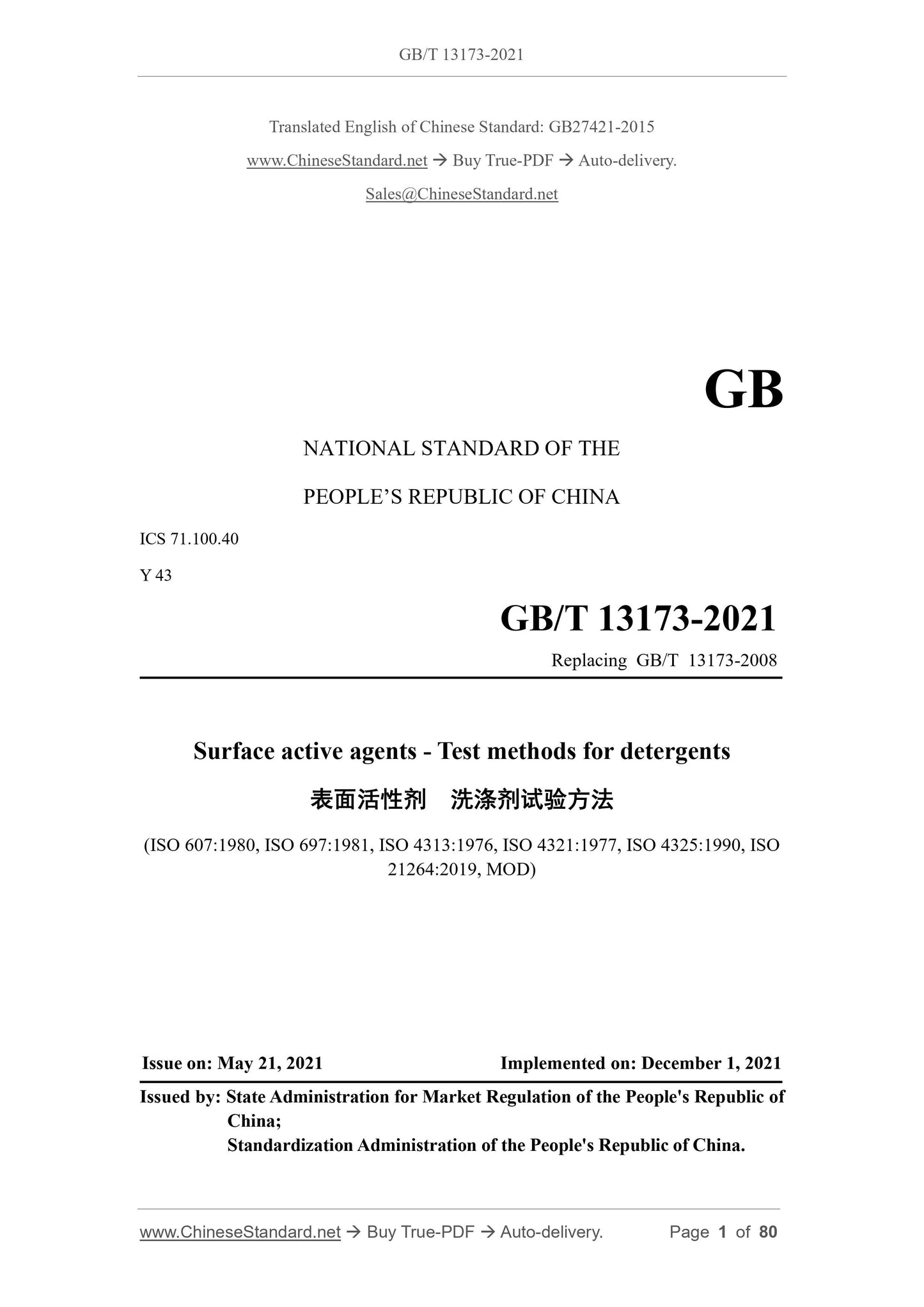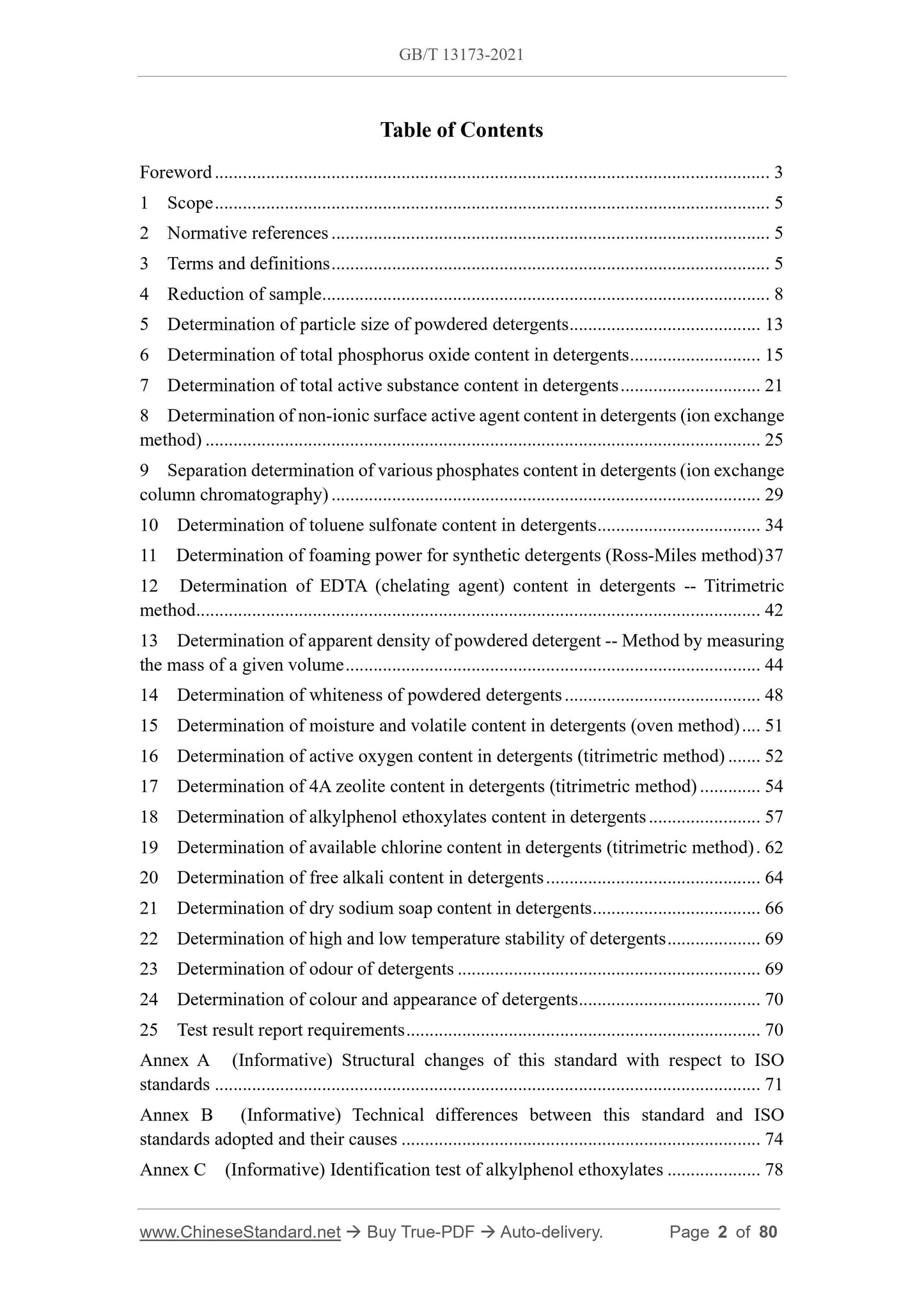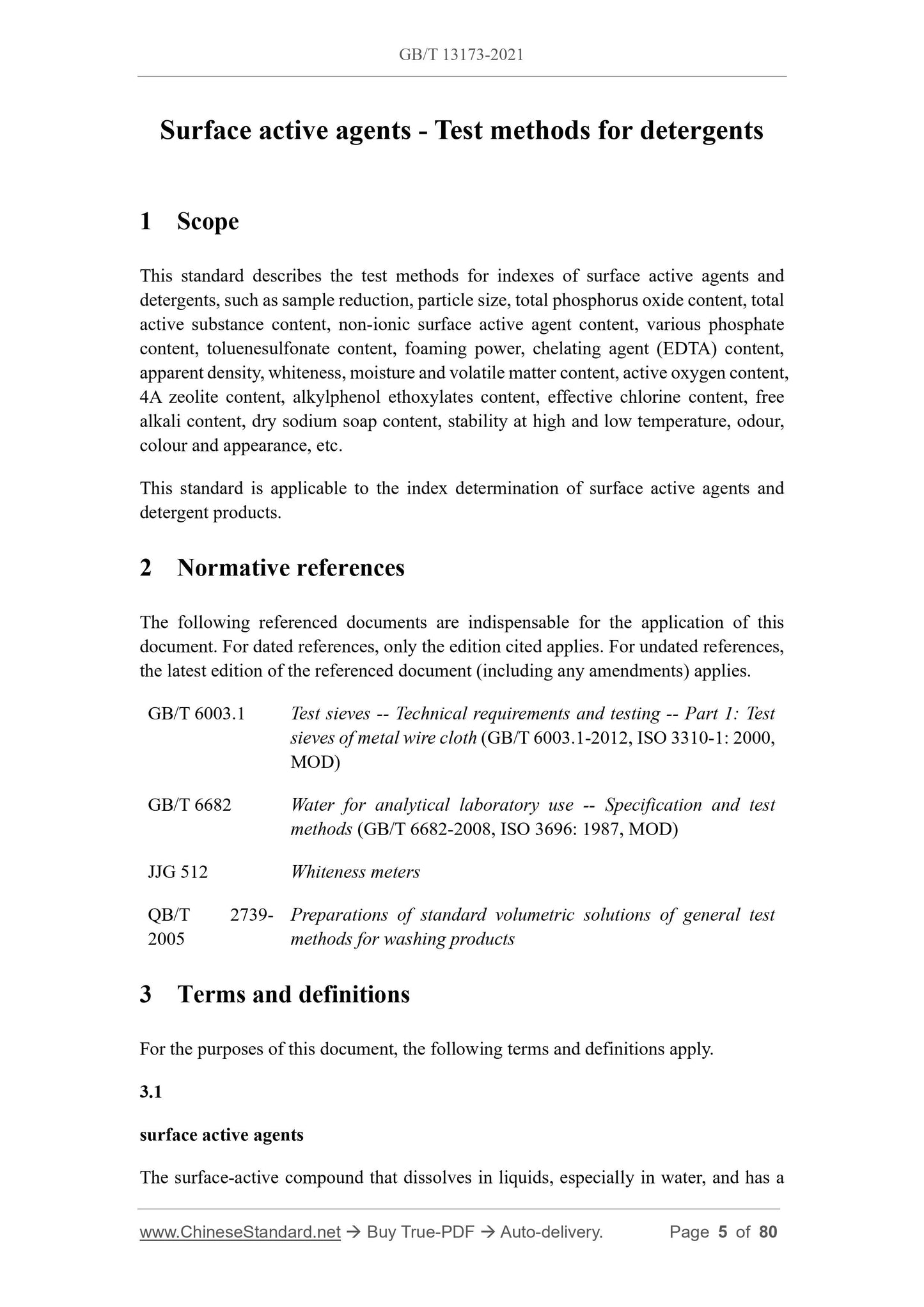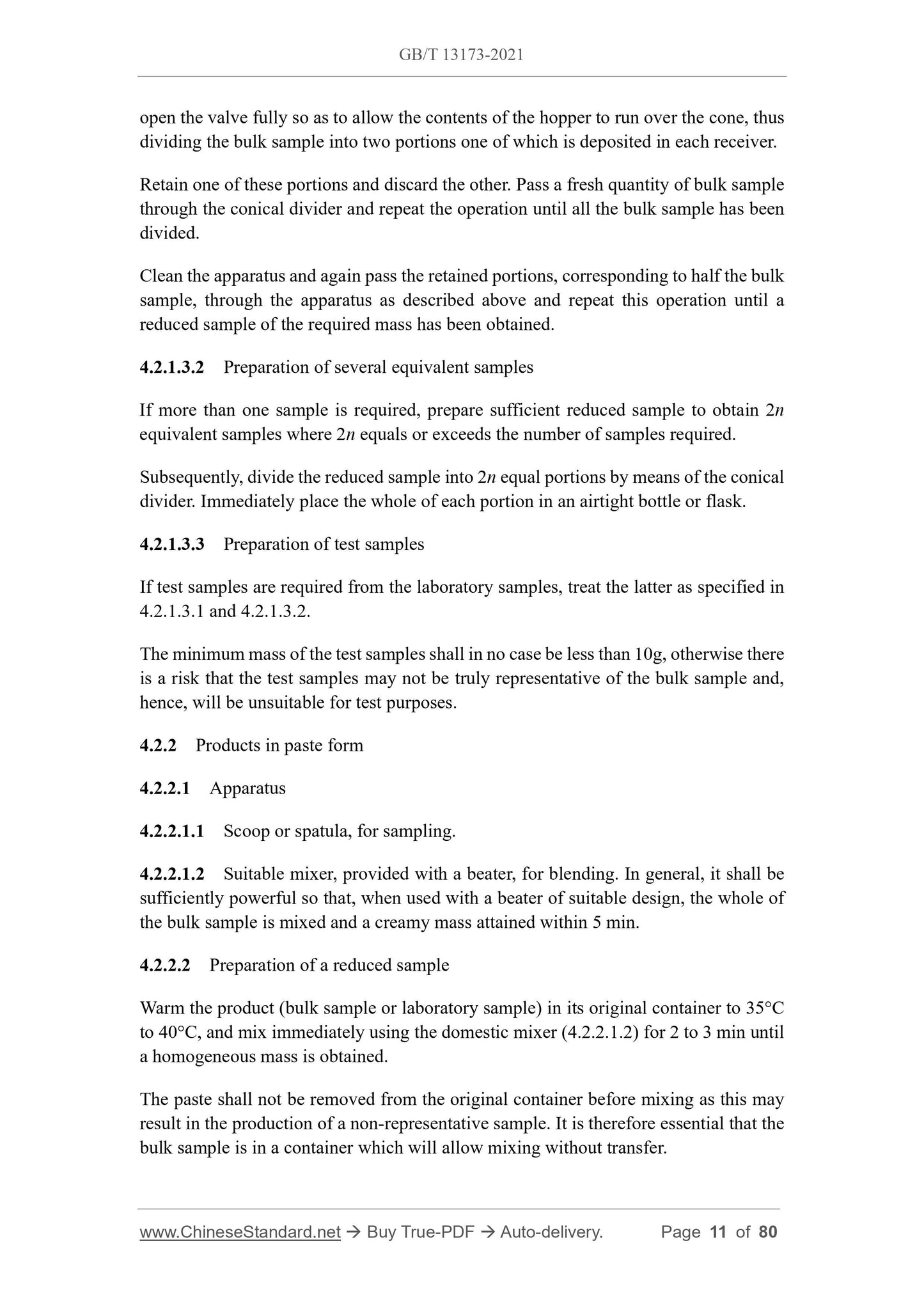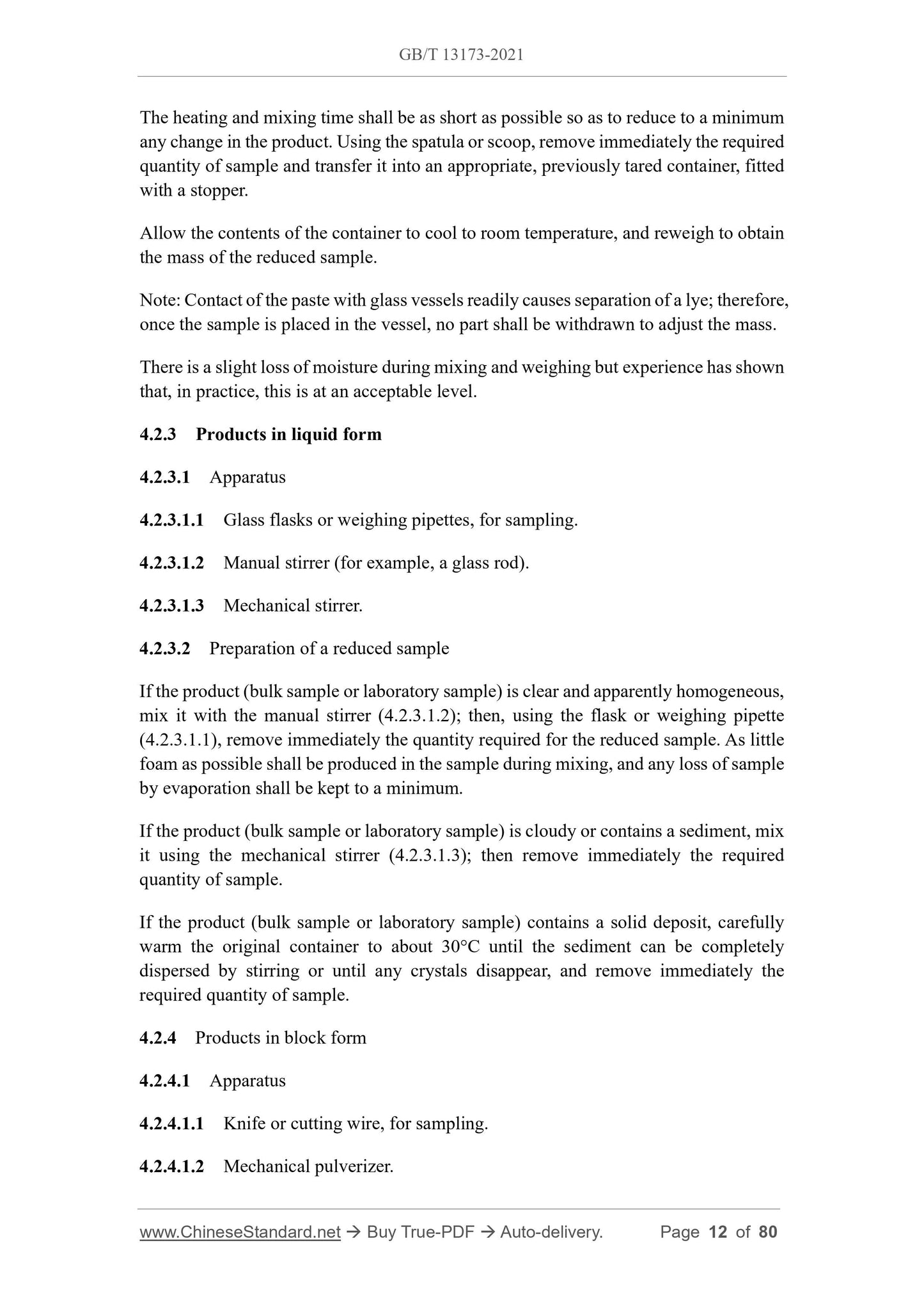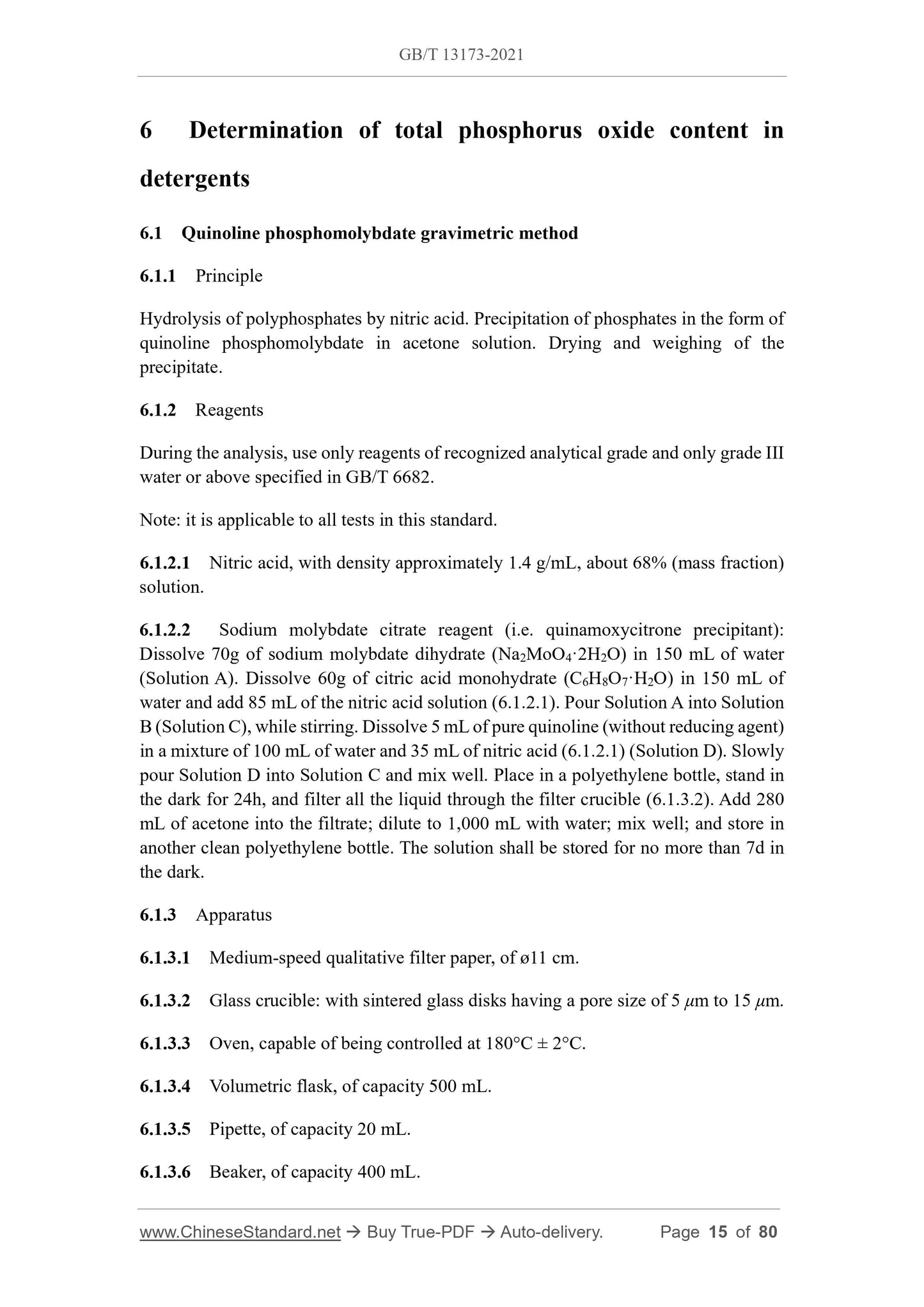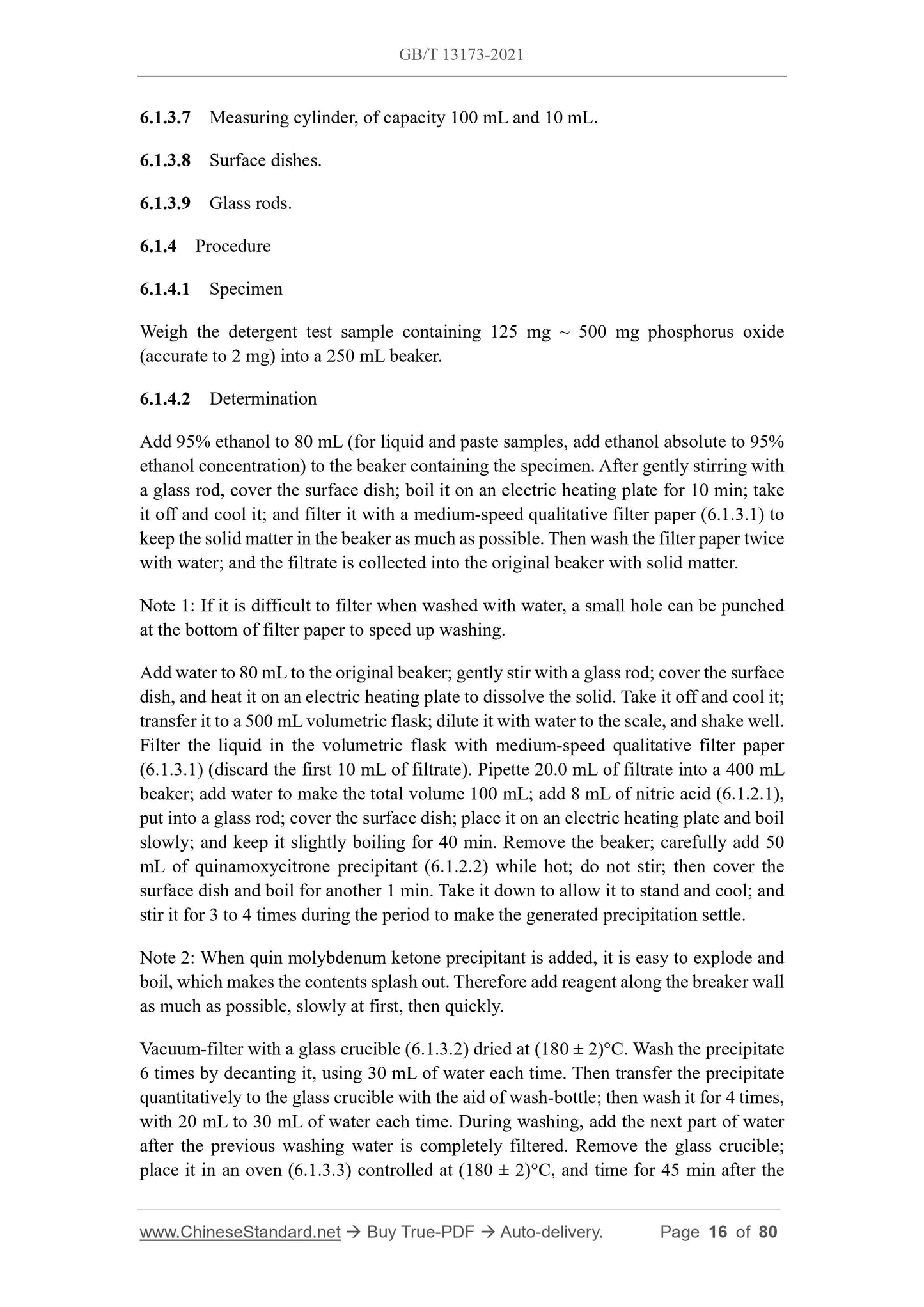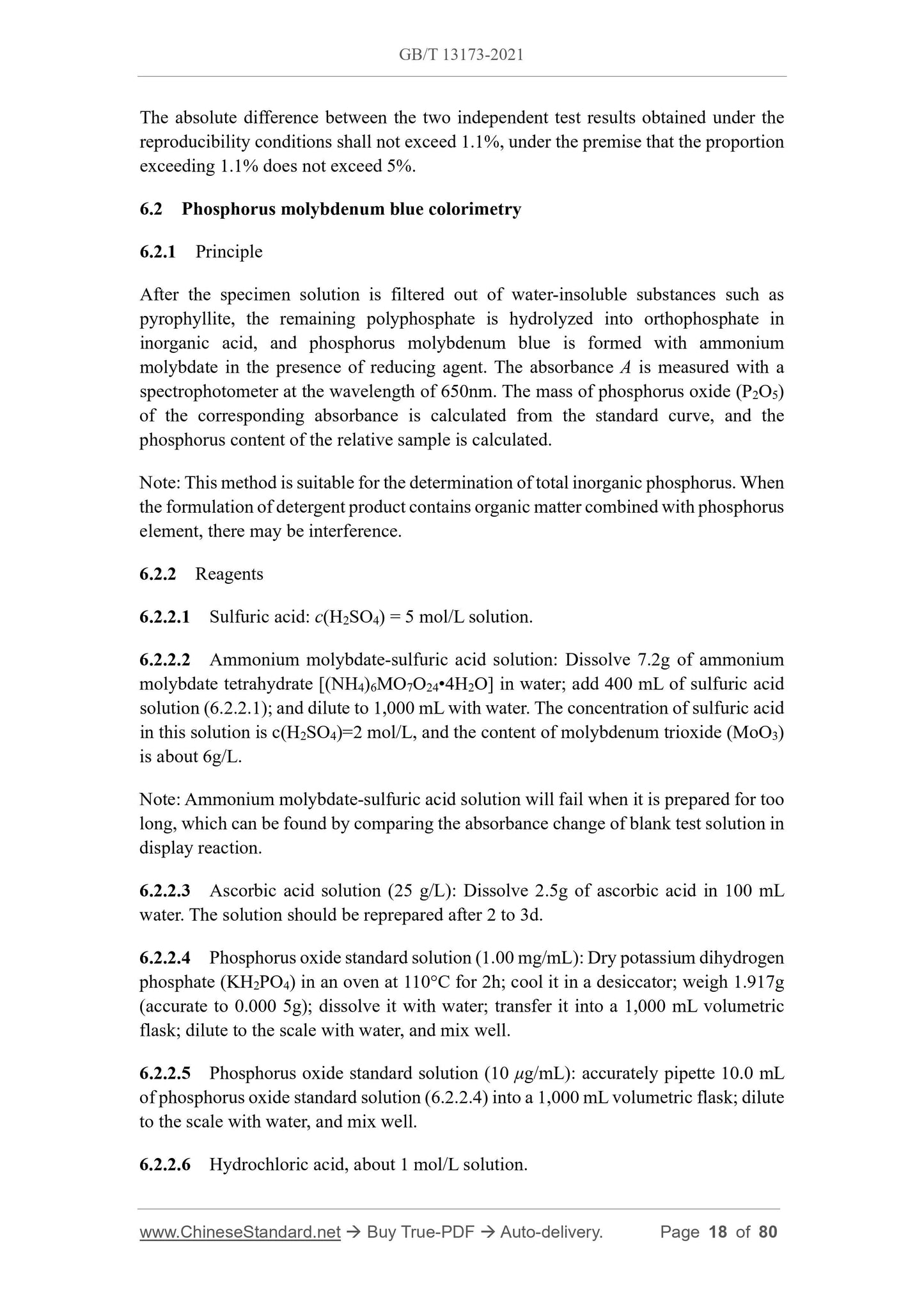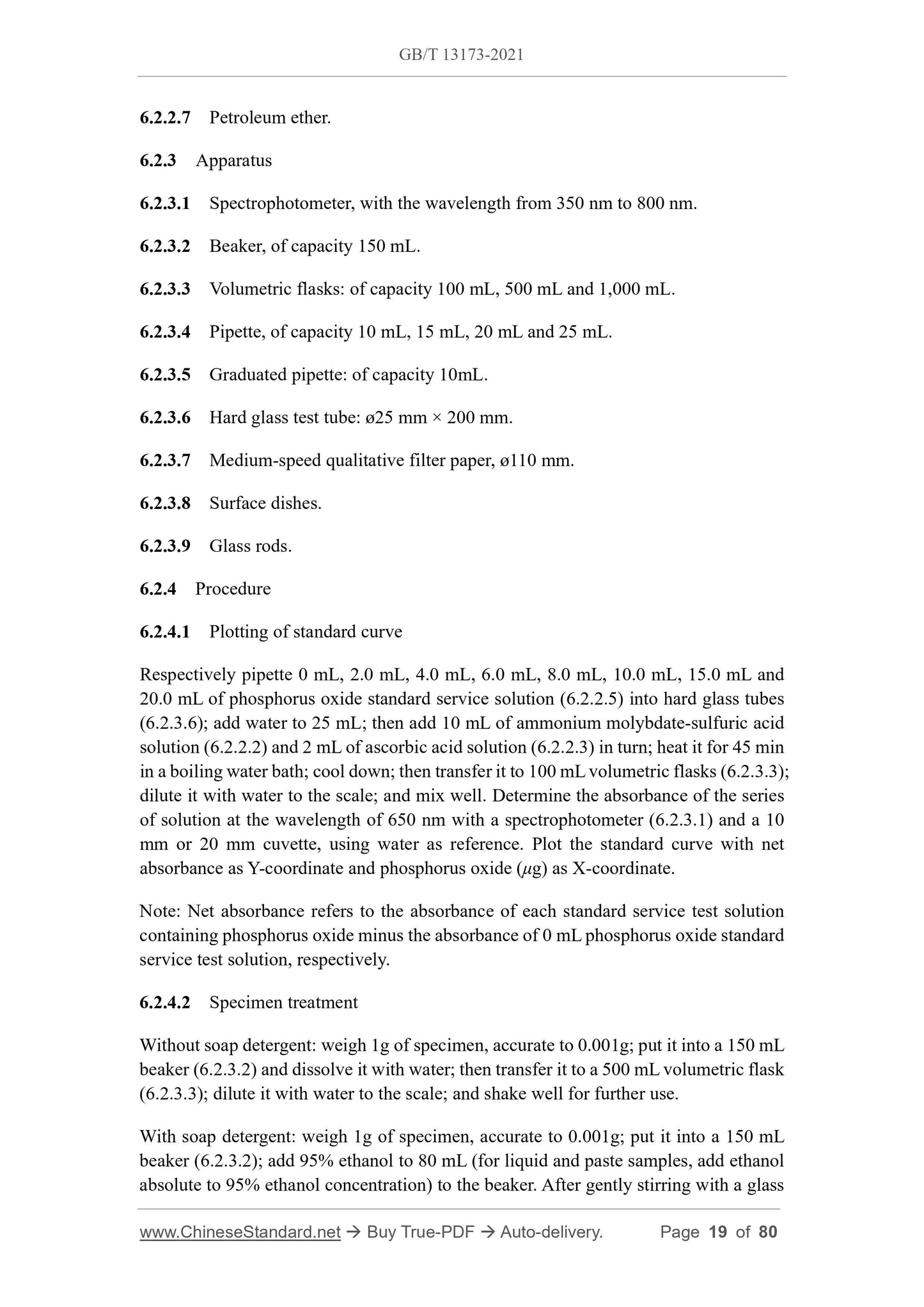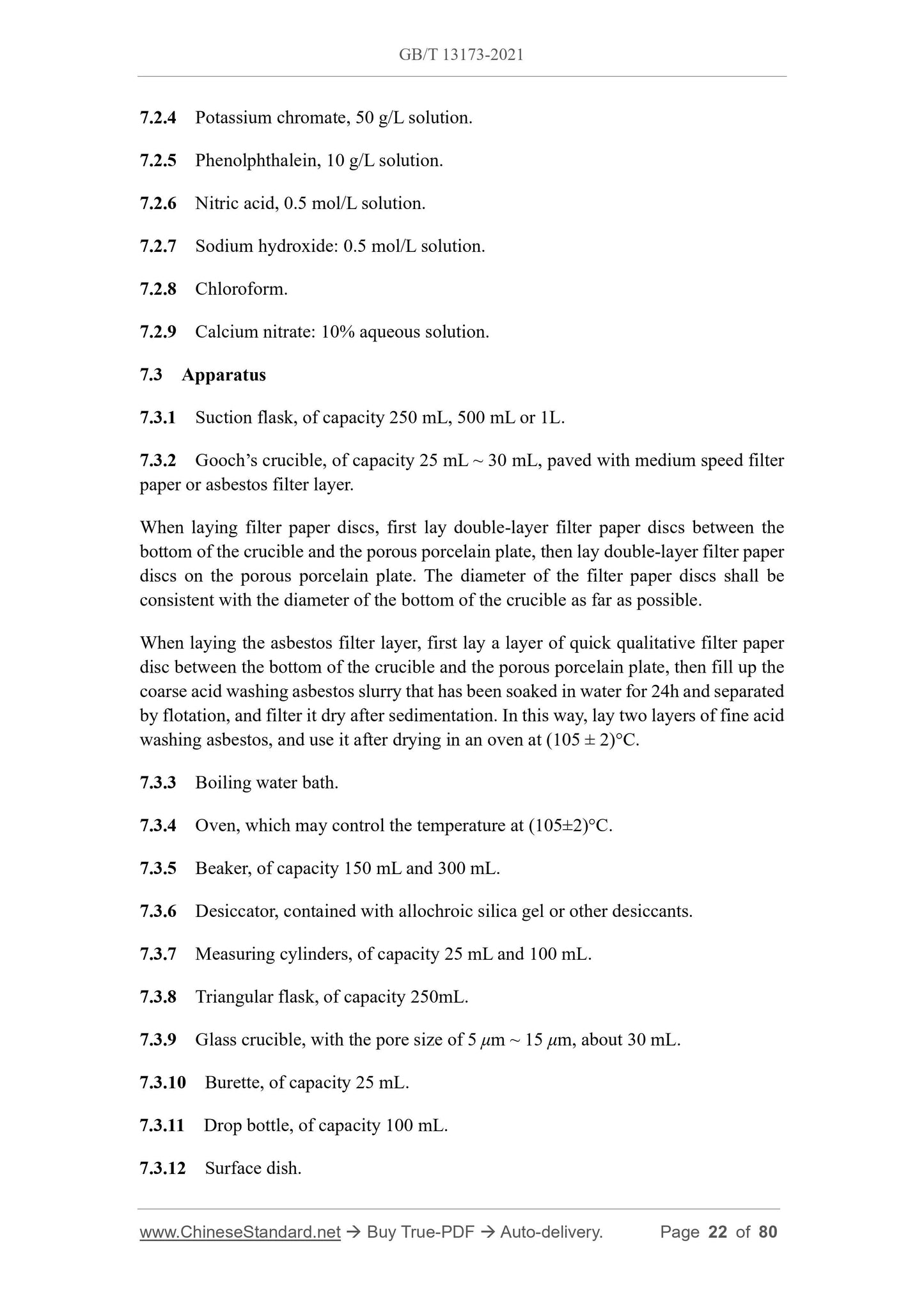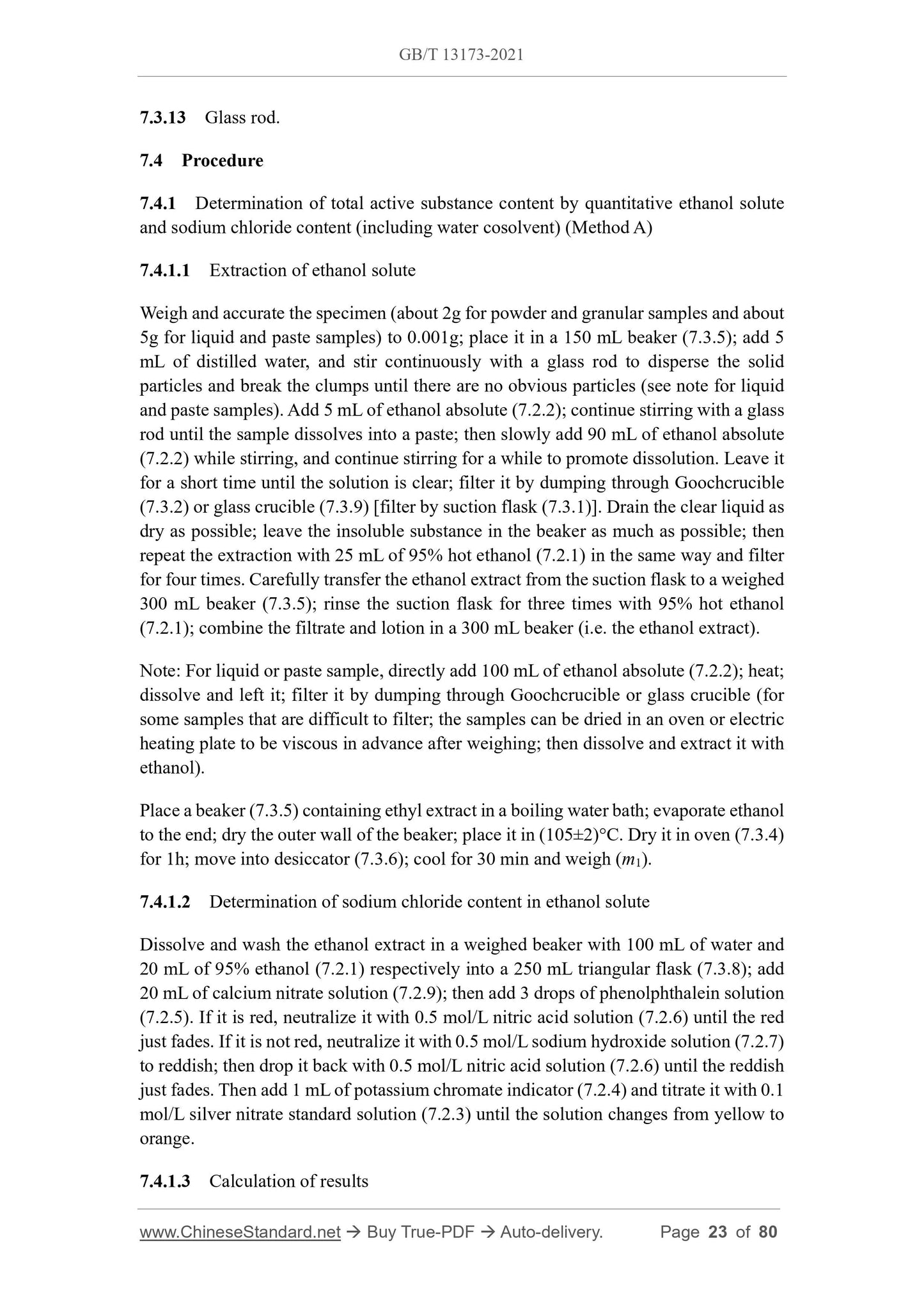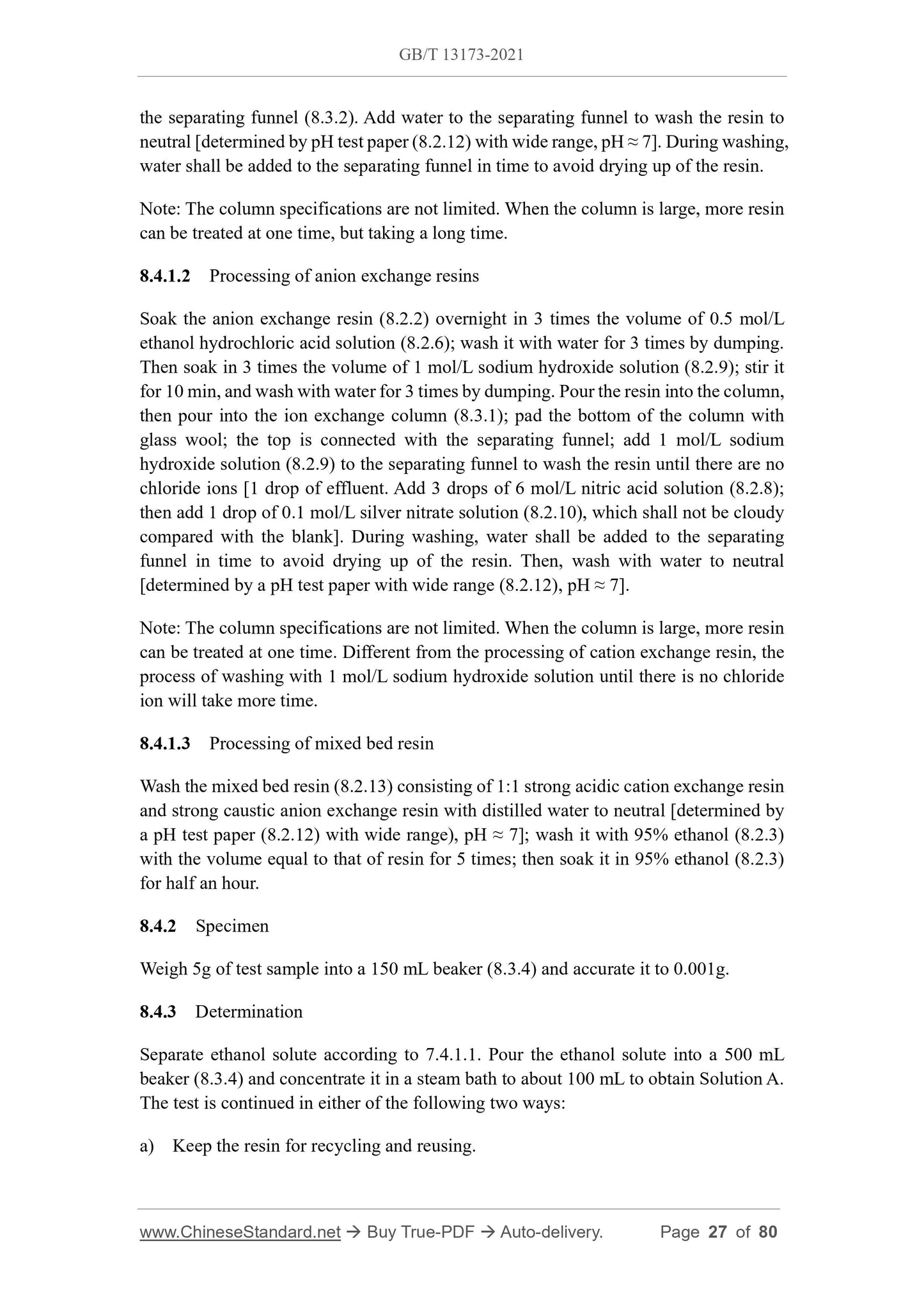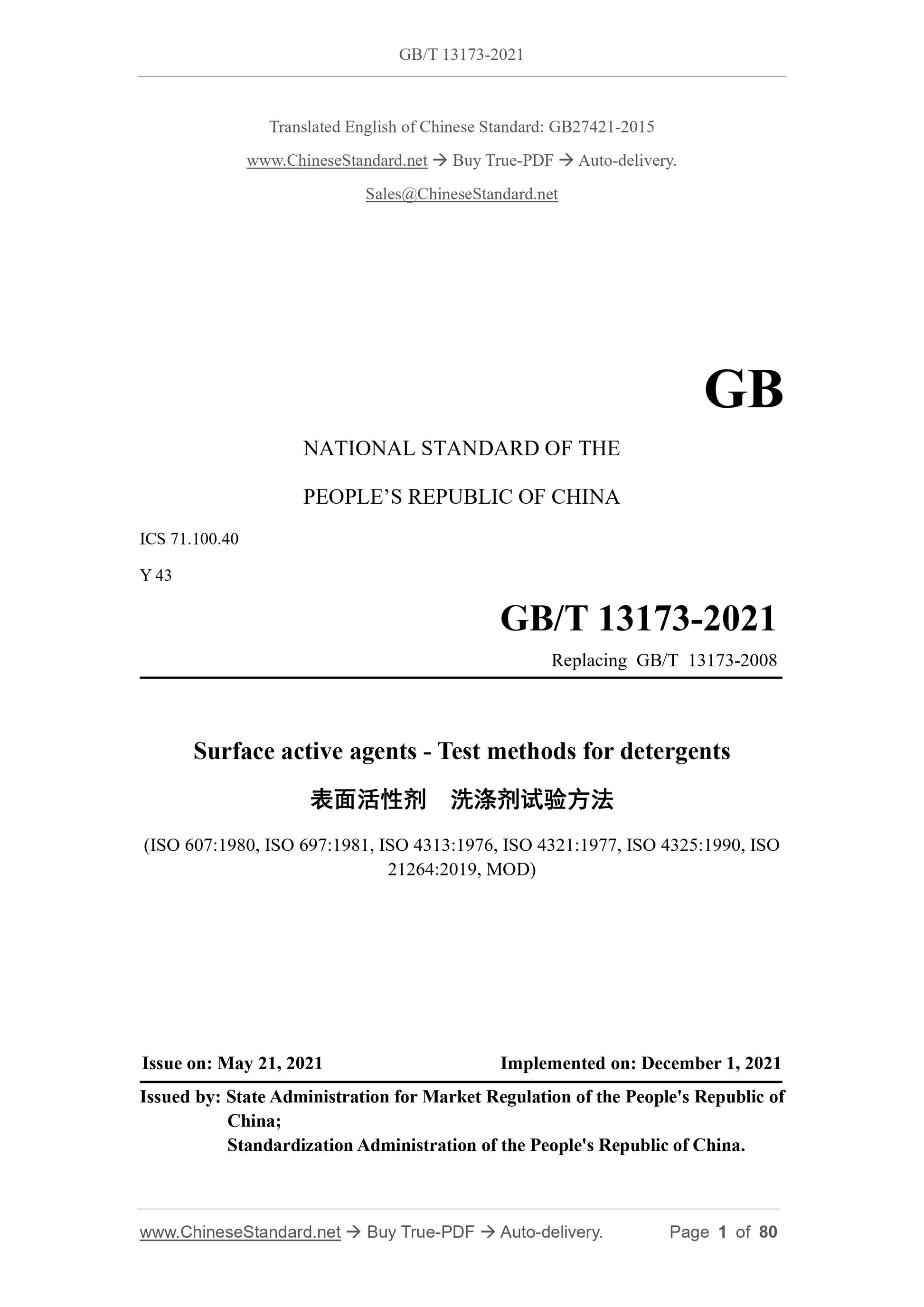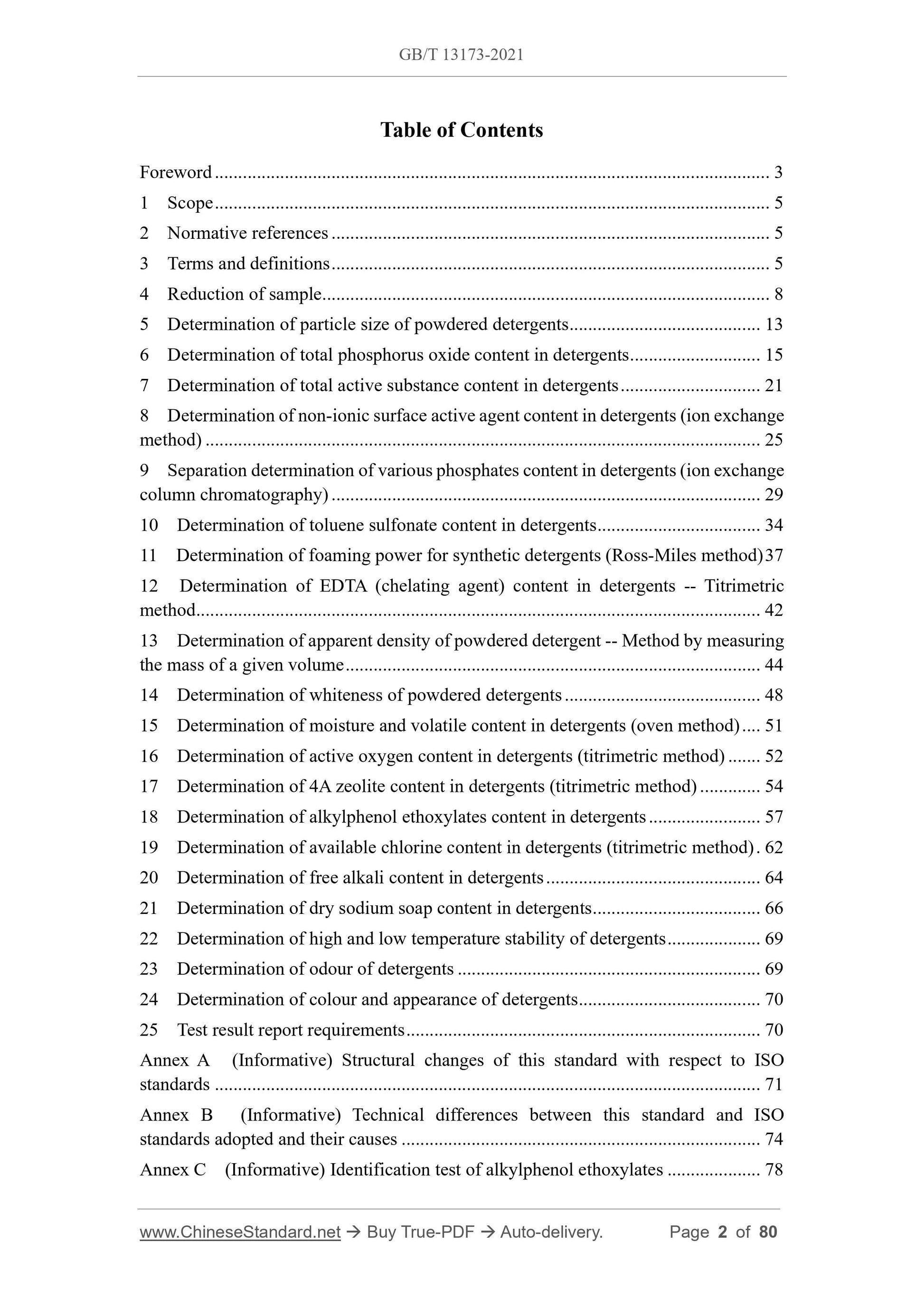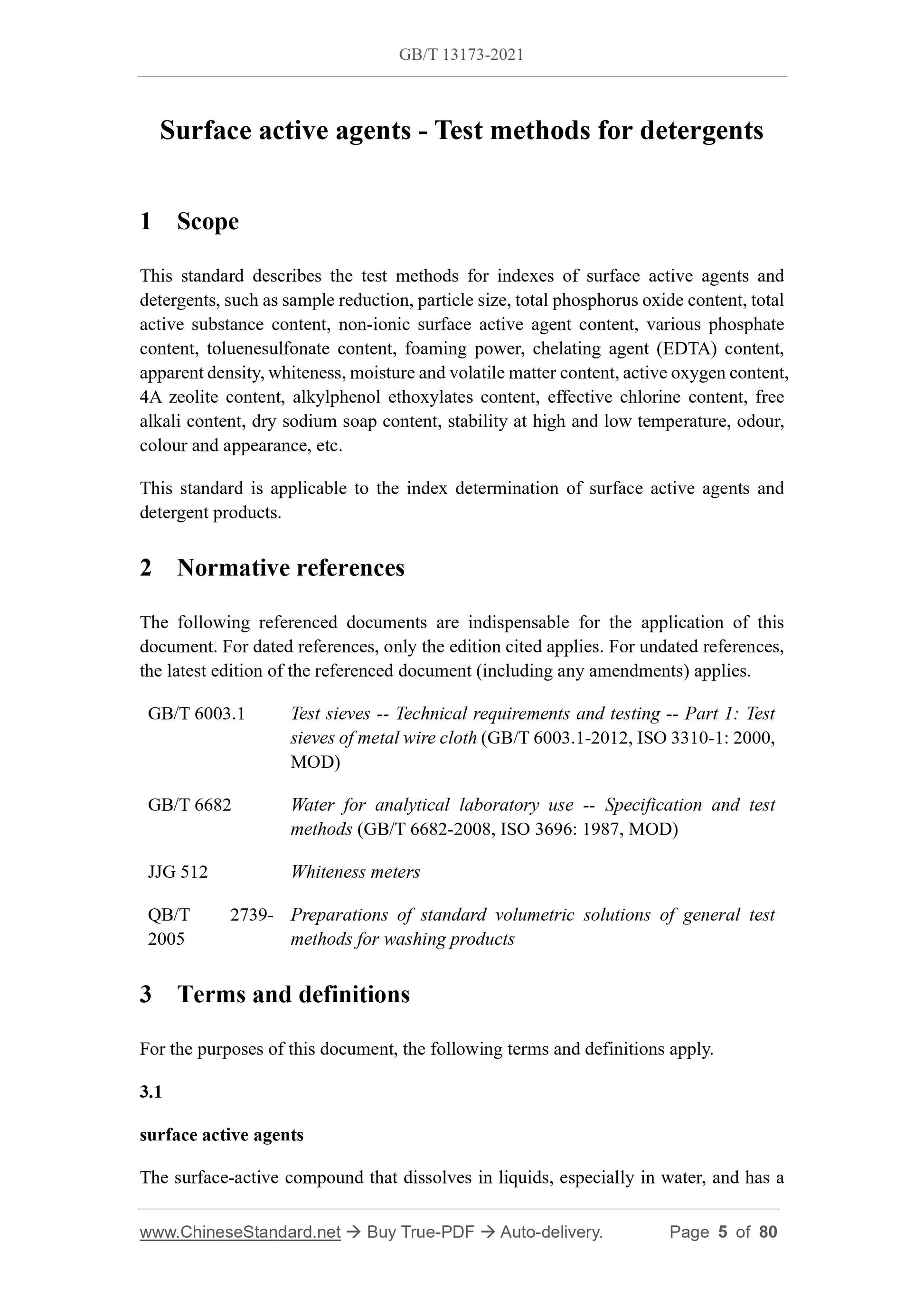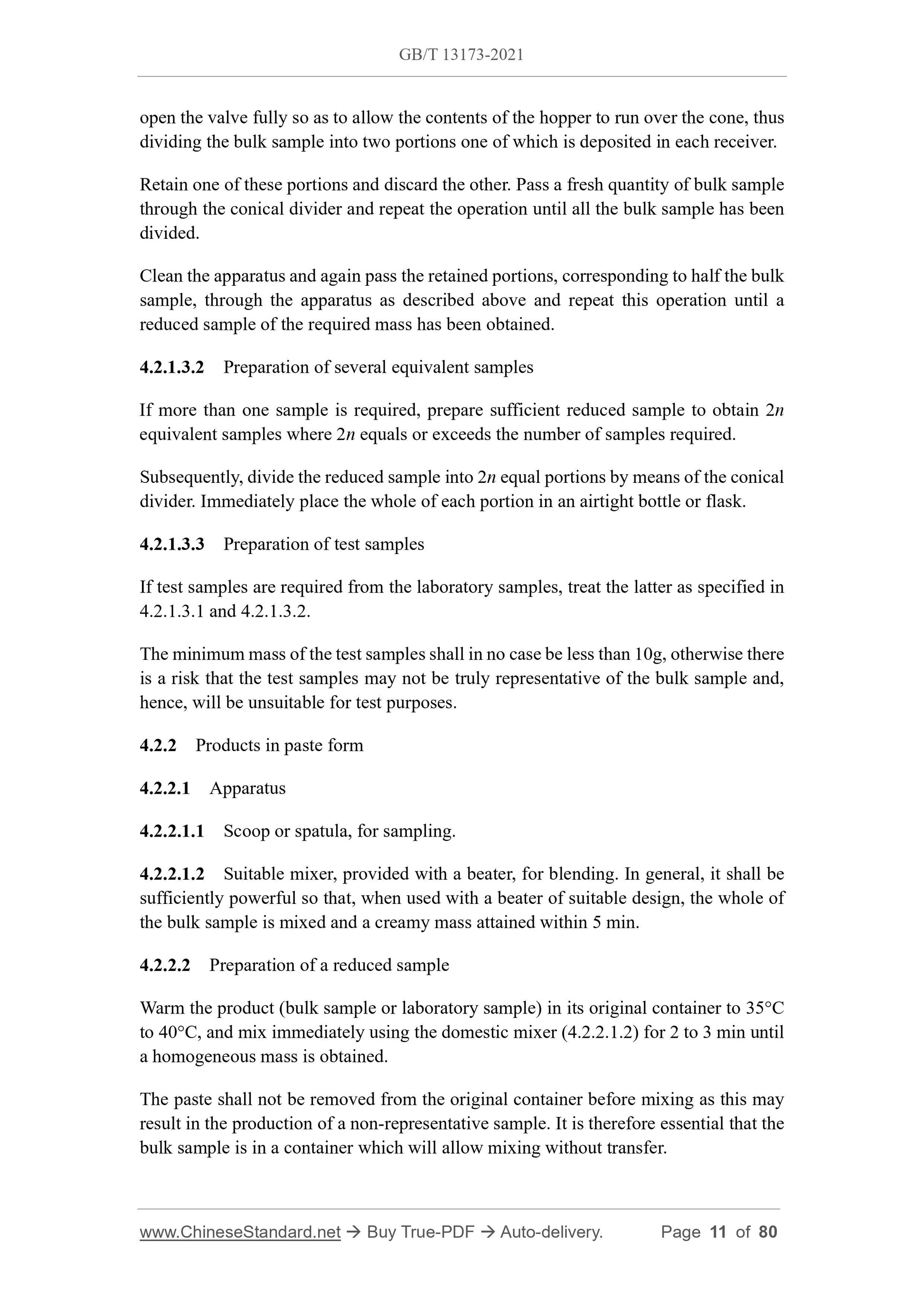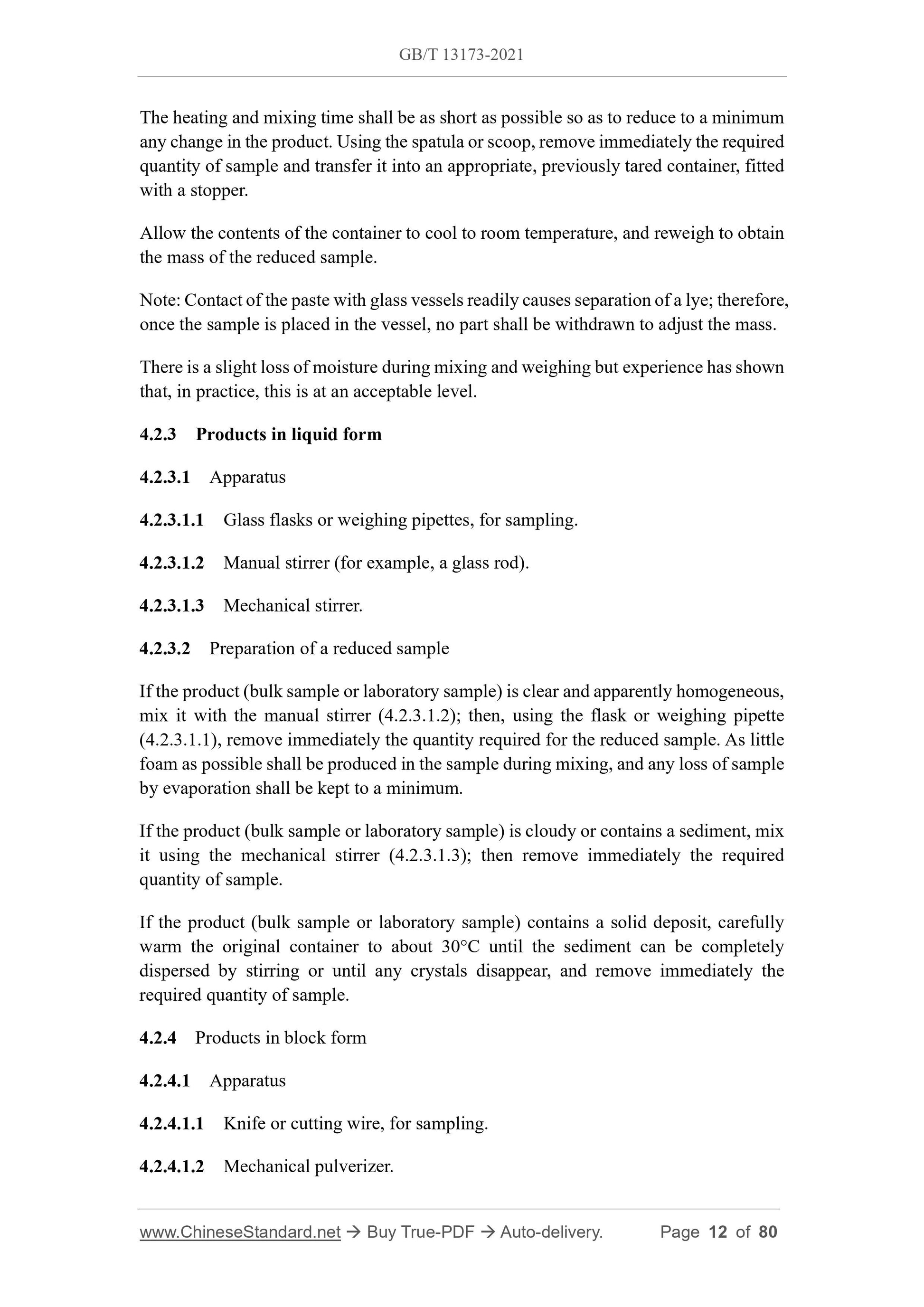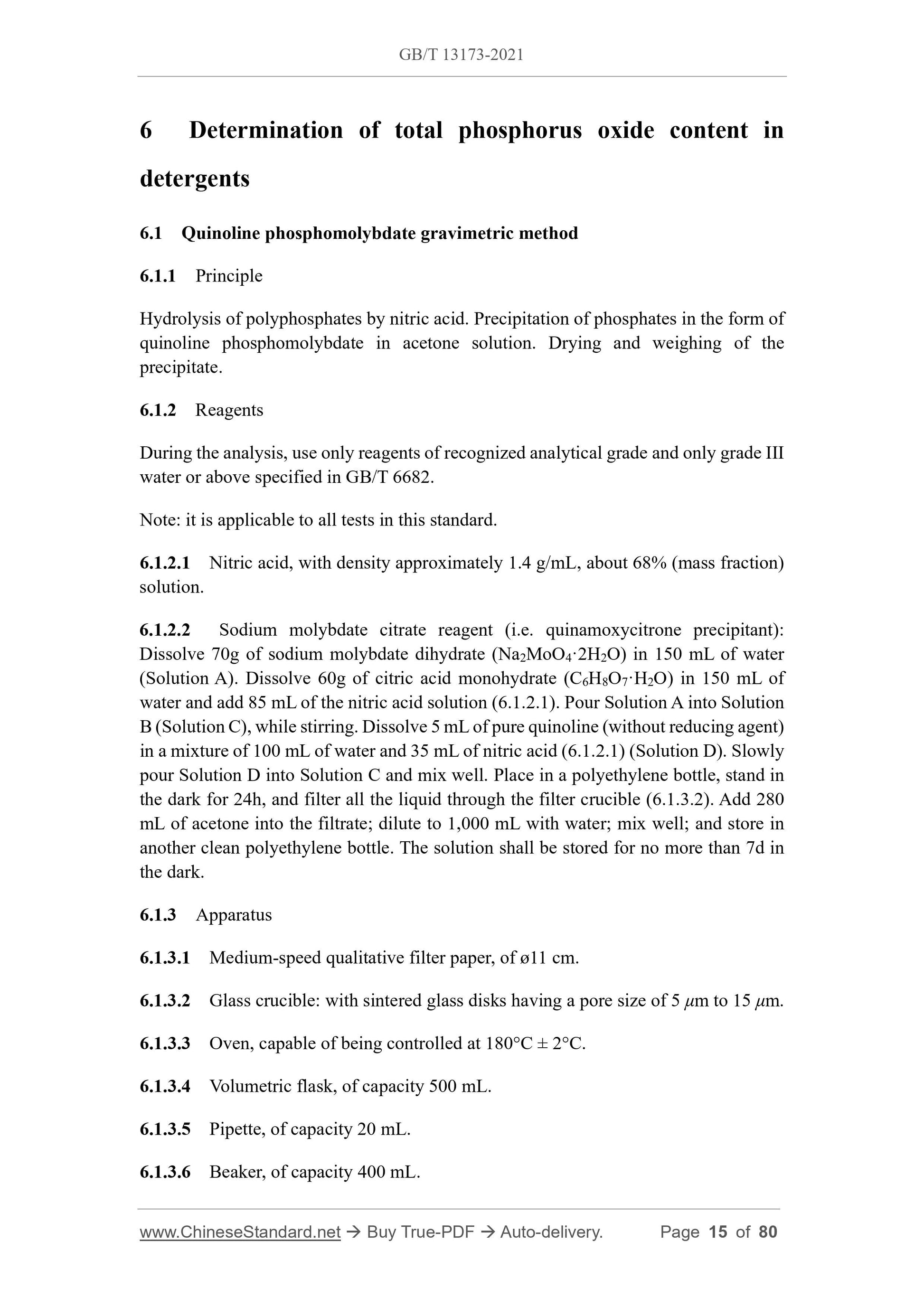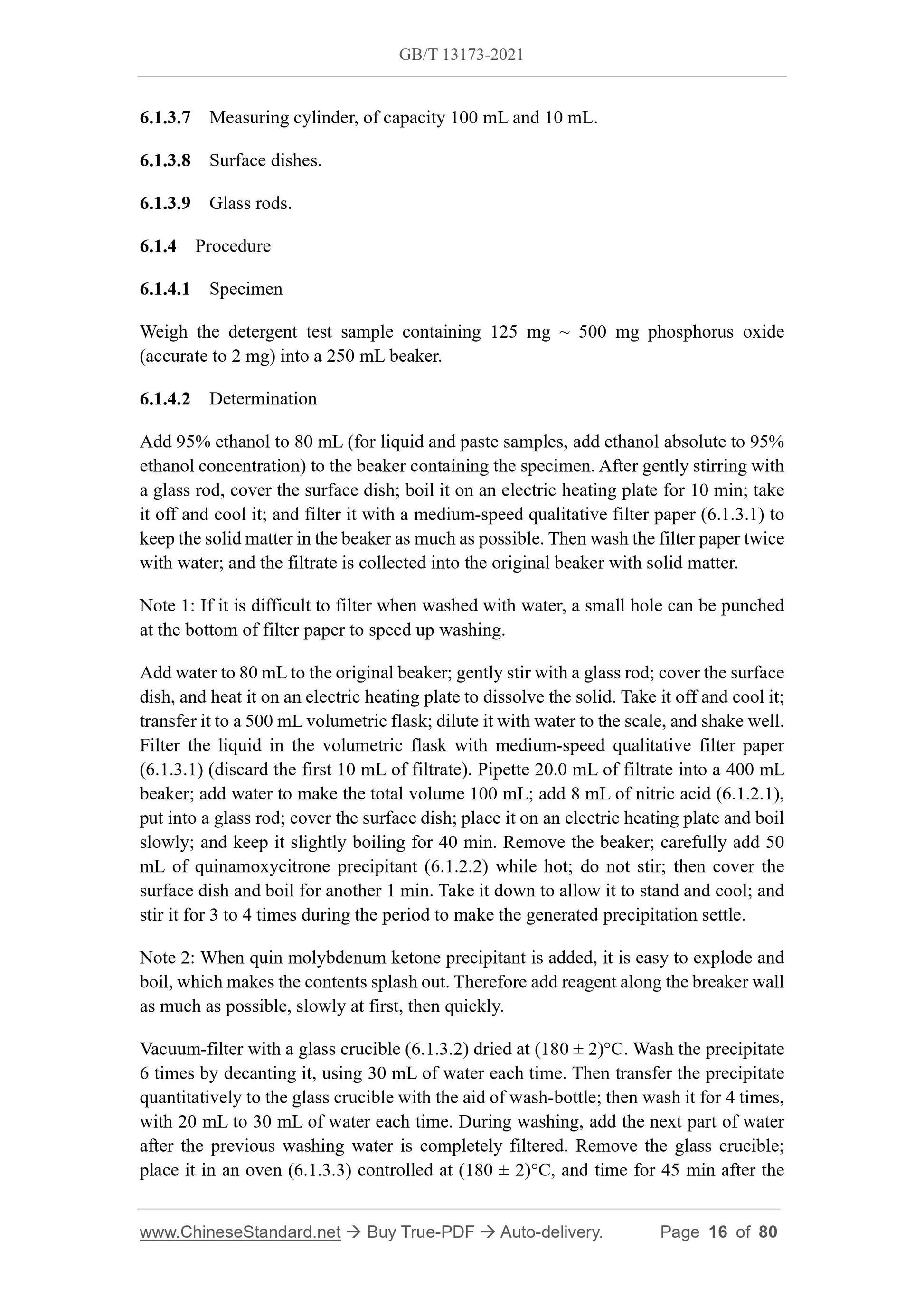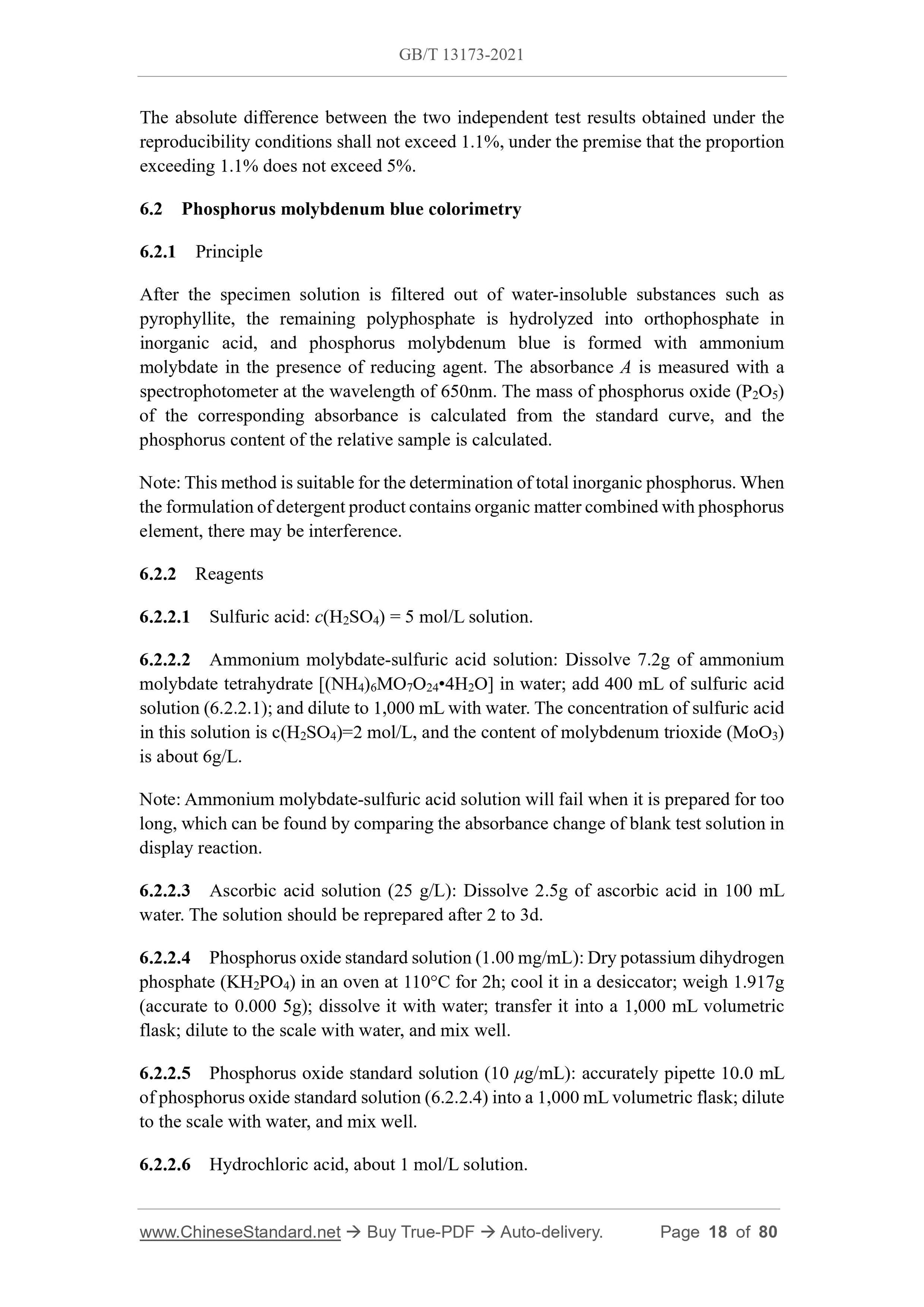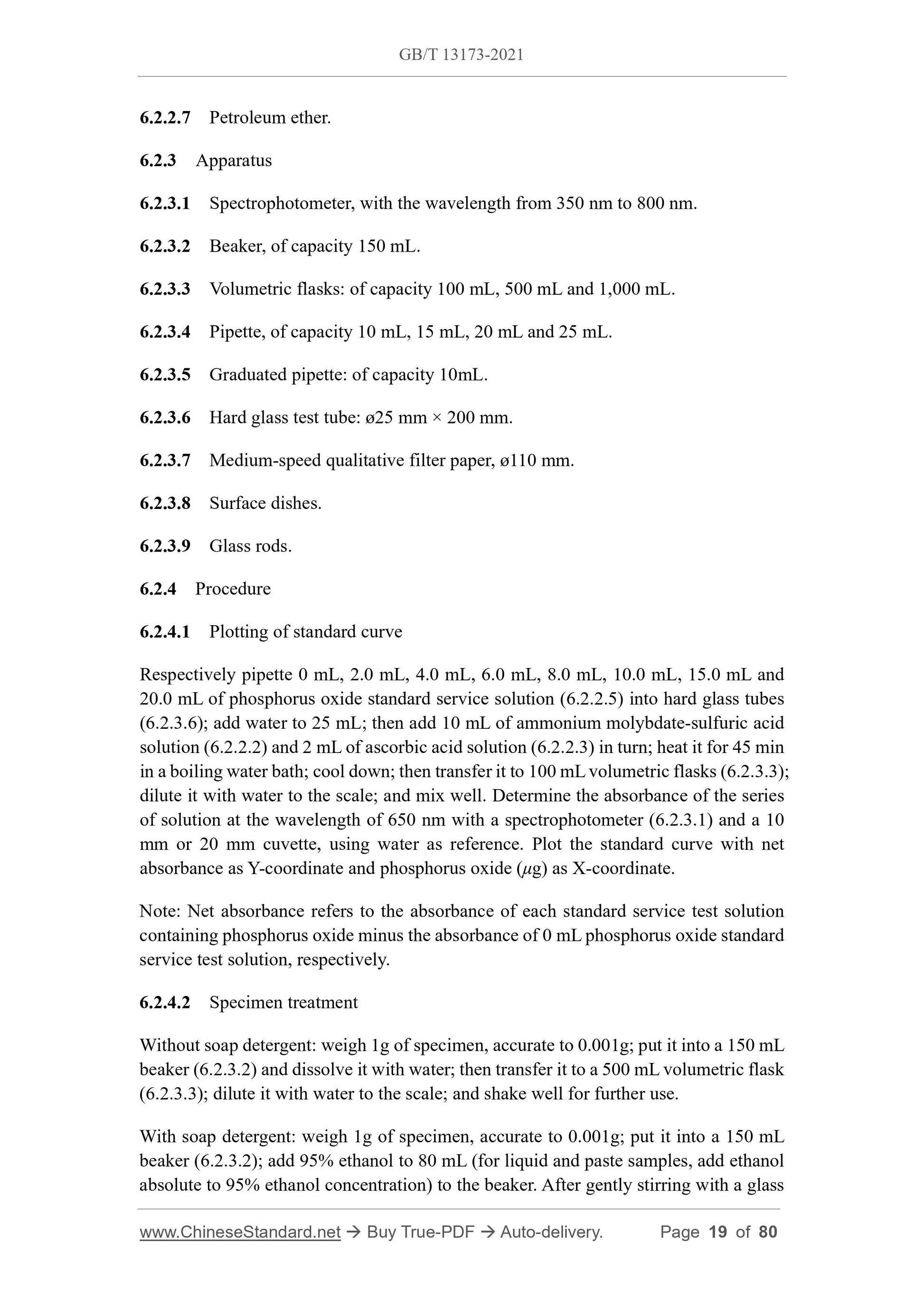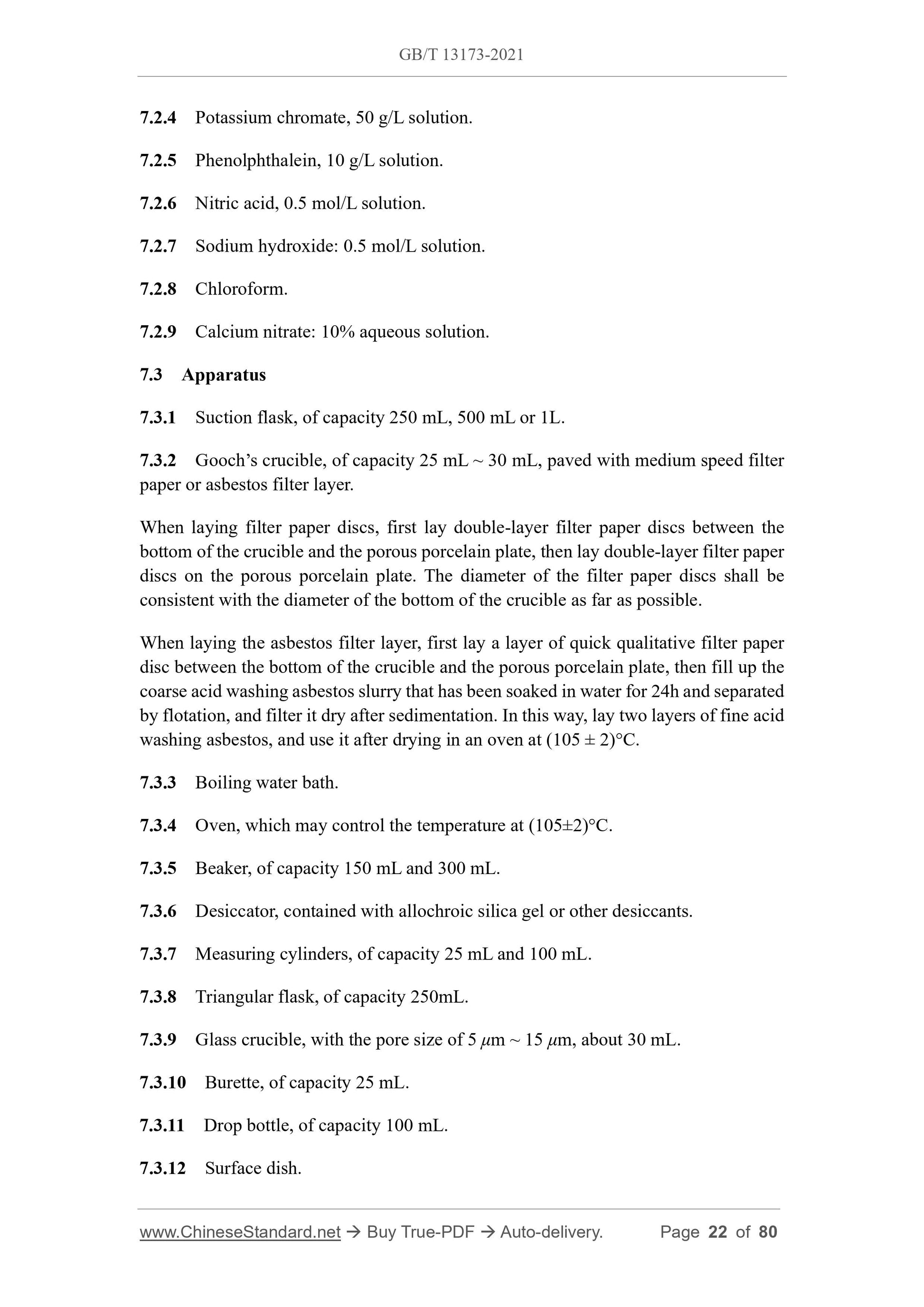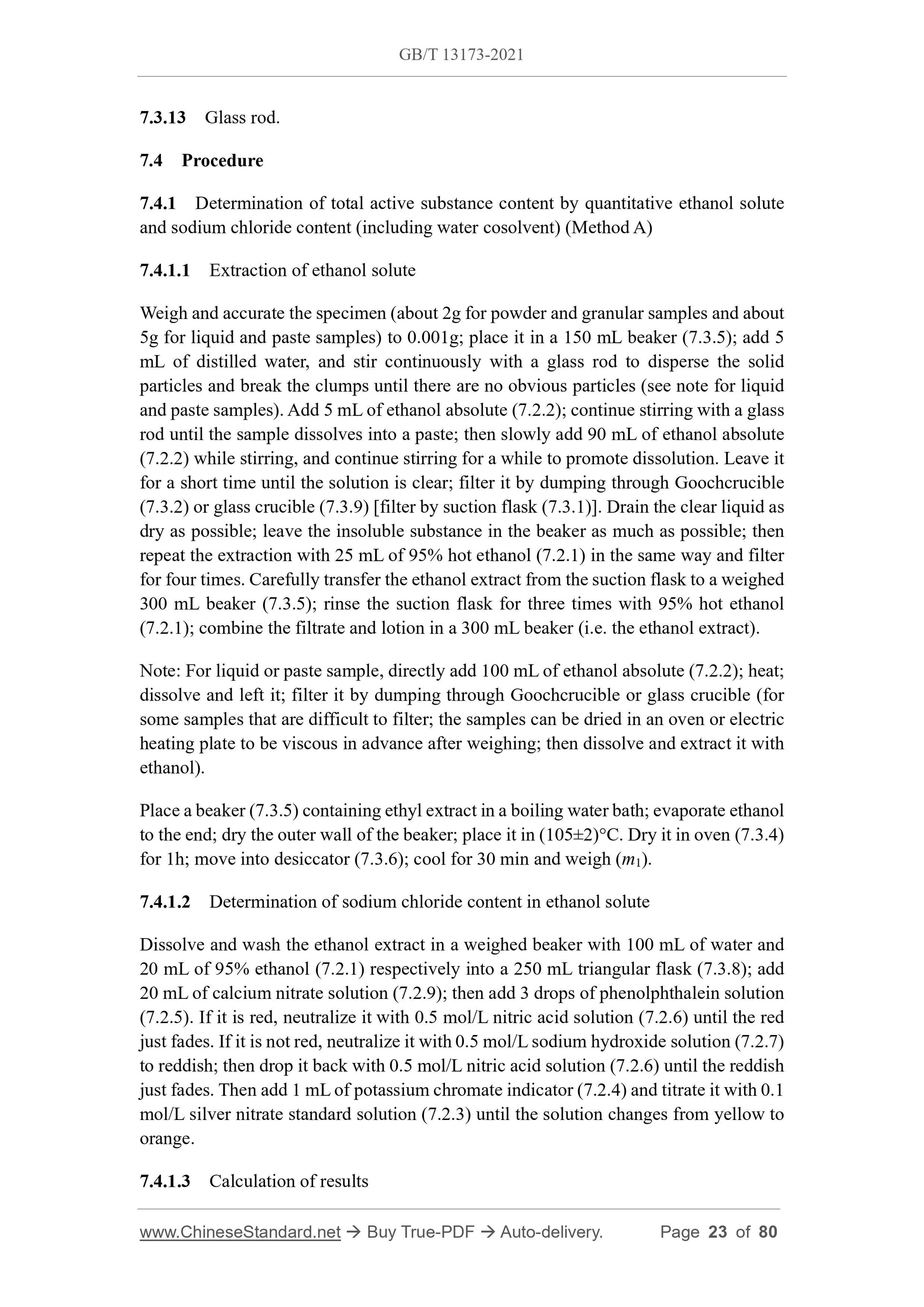1
/
of
12
www.ChineseStandard.us -- Field Test Asia Pte. Ltd.
GB/T 13173-2021 English PDF (GB/T13173-2021)
GB/T 13173-2021 English PDF (GB/T13173-2021)
Regular price
$905.00
Regular price
Sale price
$905.00
Unit price
/
per
Shipping calculated at checkout.
Couldn't load pickup availability
GB/T 13173-2021: Surface active agents - Test methods for detergents
Delivery: 9 seconds. Download (& Email) true-PDF + Invoice.
Get Quotation: Click GB/T 13173-2021 (Self-service in 1-minute)
Historical versions (Master-website): GB/T 13173-2021
Preview True-PDF (Reload/Scroll-down if blank)
GB/T 13173-2021
NATIONAL STANDARD OF THE
PEOPLE’S REPUBLIC OF CHINA
ICS 71.100.40
Y 43
Replacing GB/T 13173-2008
Surface active agents - Test methods for detergents
(ISO 607:1980, ISO 697:1981, ISO 4313:1976, ISO 4321:1977, ISO 4325:1990, ISO
21264:2019, MOD)
ISSUE ON: MAY 21, 2021
IMPLEMENTED ON: DECEMBER 1, 2021
Issued by: State Administration for Market Regulation of the People's Republic of
China;
Standardization Administration of the People's Republic of China.
Table of Contents
Foreword ... 3
1 Scope ... 5
2 Normative references ... 5
3 Terms and definitions ... 5
4 Reduction of sample ... 8
5 Determination of particle size of powdered detergents ... 13
6 Determination of total phosphorus oxide content in detergents ... 15
7 Determination of total active substance content in detergents ... 21
8 Determination of non-ionic surface active agent content in detergents (ion exchange
method) ... 25
9 Separation determination of various phosphates content in detergents (ion exchange
column chromatography) ... 29
10 Determination of toluene sulfonate content in detergents ... 34
11 Determination of foaming power for synthetic detergents (Ross-Miles method) 37
12 Determination of EDTA (chelating agent) content in detergents -- Titrimetric
method ... 42
13 Determination of apparent density of powdered detergent -- Method by measuring
the mass of a given volume ... 44
14 Determination of whiteness of powdered detergents ... 48
15 Determination of moisture and volatile content in detergents (oven method) ... 51
16 Determination of active oxygen content in detergents (titrimetric method) ... 52
17 Determination of 4A zeolite content in detergents (titrimetric method) ... 54
18 Determination of alkylphenol ethoxylates content in detergents ... 57
19 Determination of available chlorine content in detergents (titrimetric method) . 62
20 Determination of free alkali content in detergents ... 64
21 Determination of dry sodium soap content in detergents ... 66
22 Determination of high and low temperature stability of detergents ... 69
23 Determination of odour of detergents ... 69
24 Determination of colour and appearance of detergents ... 70
25 Test result report requirements ... 70
Annex A (Informative) Structural changes of this standard with respect to ISO
standards ... 71
Annex B (Informative) Technical differences between this standard and ISO
standards adopted and their causes ... 74
Annex C (Informative) Identification test of alkylphenol ethoxylates ... 78
Surface active agents - Test methods for detergents
1 Scope
This standard describes the test methods for indexes of surface active agents and
detergents, such as sample reduction, particle size, total phosphorus oxide content, total
active substance content, non-ionic surface active agent content, various phosphate
content, toluenesulfonate content, foaming power, chelating agent (EDTA) content,
apparent density, whiteness, moisture and volatile matter content, active oxygen content,
4A zeolite content, alkylphenol ethoxylates content, effective chlorine content, free
alkali content, dry sodium soap content, stability at high and low temperature, odour,
colour and appearance, etc.
This standard is applicable to the index determination of surface active agents and
detergent products.
2 Normative references
The following referenced documents are indispensable for the application of this
document. For dated references, only the edition cited applies. For undated references,
the latest edition of the referenced document (including any amendments) applies.
GB/T 6003.1 Test sieves -- Technical requirements and testing -- Part 1: Test
sieves of metal wire cloth (GB/T 6003.1-2012, ISO 3310-1: 2000,
MOD)
GB/T 6682 Water for analytical laboratory use -- Specification and test
methods (GB/T 6682-2008, ISO 3696: 1987, MOD)
JJG 512 Whiteness meters
QB/T 2739-
2005
Preparations of standard volumetric solutions of general test
methods for washing products
3 Terms and definitions
For the purposes of this document, the following terms and definitions apply.
3.1
surface active agents
The surface-active compound that dissolves in liquids, especially in water, and has a
open the valve fully so as to allow the contents of the hopper to run over the cone, thus
dividing the bulk sample into two portions one of which is deposited in each receiver.
Retain one of these portions and discard the other. Pass a fresh quantity of bulk sample
through the conical divider and repeat the operation until all the bulk sample has been
divided.
Clean the apparatus and again pass the retained portions, corresponding to half the bulk
sample, through the apparatus as described above and repeat this operation until a
reduced sample of the required mass has been obtained.
4.2.1.3.2 Preparation of several equivalent samples
If more than one sample is required, prepare sufficient reduced sample to obtain 2n
equivalent samples where 2n equals or exceeds the number of samples required.
Subsequently, divide the reduced sample into 2n equal portions by means of the conical
divider. Immediately place the whole of each portion in an airtight bottle or flask.
4.2.1.3.3 Preparation of test samples
If test samples are required from the laboratory samples, treat the latter as specified in
4.2.1.3.1 and 4.2.1.3.2.
The minimum mass of the test samples shall in no case be less than 10g, otherwise there
is a risk that the test samples may not be truly representative of the bulk sample and,
hence, will be unsuitable for test purposes.
4.2.2 Products in paste form
4.2.2.1 Apparatus
4.2.2.1.1 Scoop or spatula, for sampling.
4.2.2.1.2 Suitable mixer, provided with a beater, for blending. In general, it shall be
sufficiently powerful so that, when used with a beater of suitable design, the whole of
the bulk sample is mixed and a creamy mass attained within 5 min.
4.2.2.2 Preparation of a reduced sample
Warm the product (bulk sample or laboratory sample) in its original container to 35°C
to 40°C, and mix immediately using the domestic mixer (4.2.2.1.2) for 2 to 3 min until
a homogeneous mass is obtained.
The paste shall not be removed from the original container before mixing as this may
result in the production of a non-representative sample. It is therefore essential that the
bulk sample is in a container which will allow mixing without transfer.
The heating and mixing time shall be as short as possible so as to reduce to a minimum
any change in the product. Using the spatula or scoop, remove immediately the required
quantity of sample and transfer it into an appropriate, previously tared container, fitted
with a stopper.
Allow the contents of the container to cool to room temperature, and reweigh to obtain
the mass of the reduced sample.
Note: Contact of the paste with glass vessels readily causes separation of a lye; therefore,
once the sample is placed in the vessel, no part shall be withdrawn to adjust the mass.
There is a slight loss of moisture during mixing and weighing but experience has shown
that, in practice, this is at an acceptable level.
4.2.3 Products in liquid form
4.2.3.1 Apparatus
4.2.3.1.1 Glass flasks or weighing pipettes, for sampling.
4.2.3.1.2 Manual stirrer (for example, a glass rod).
4.2.3.1.3 Mechanical stirrer.
4.2.3.2 Preparation of a reduced sample
If the product (bulk sample or laboratory sample) is clear and apparently homogeneous,
mix it with the manual stirrer (4.2.3.1.2); then, using the flask or weighing pipette
(4.2.3.1.1), remove immediately the quantity required for the reduced sample. As little
foam as possible shall be produced in the sample during mixing, and any loss of sample
by evaporation shall be kept to a minimum.
If the product (bulk sample or laboratory sample) is cloudy or contains a sediment, mix
it using the mechanical stirrer (4.2.3.1.3); then remove immediately the required
quantity of sample.
If the product (bulk sample or laboratory sample) contains a solid deposit, carefully
warm the original container to about 30°C until the sediment can be completely
dispersed by stirring or until any crystals disappear, and remove immediately the
required quantity of sample.
4.2.4 Products in block form
4.2.4.1 Apparatus
4.2.4.1.1 Knife or cutting wire, for sampling.
4.2.4.1.2 Mechanical pulverizer.
6 Determination of total phosphorus oxide content in
detergents
6.1 Quinoline phosphomolybdate gravimetric method
6.1.1 Principle
Hydrolysis of polyphosphates by nitric acid. Precipitation of phosphates in the form of
quinoline phosphomolybdate in acetone solution. Drying and weighing of the
precipitate.
6.1.2 Reagents
During the analysis, use only reagents of recognized analytical grade and only grade III
water or above specified in GB/T 6682.
Note: it is applicable to all tests in this standard.
6.1.2.1 Nitric acid, with density approximately 1.4 g/mL, about 68% (mass fraction)
solution.
6.1.2.2 Sodium molybdate citrate reagent (i.e. quinamoxycitrone precipitant):
Dissolve 70g of sodium molybdate dihydrate (Na2MoO4·2H2O) in 150 mL of water
(Solution A). Dissolve 60g of citric acid monohydrate (C6H8O7·H2O) in 150 mL of
water and add 85 mL of the nitric acid solution (6.1.2.1). Pour Solution A into Solution
B (Solution C), while stirring. Dissolve 5 mL of pure quinoline (without reducing agent)
in a mixture of 100 mL of water and 35 mL of nitric acid (6.1.2.1) (Solution D). Slowly
pour Solution D into Solution C and mix well. Place in a polyethylene bottle, stand in
the dark for 24h, and filter all the liquid through the filter crucible (6.1.3.2). Add 280
mL of acetone into the filtrate; dilute to 1,000 mL with water; mix well; and store in
another clean polyethylene bottle. The solution shall be stored for no more than 7d in
the dark.
6.1.3 Apparatus
6.1.3.1 Medium-speed qualitative filter paper, of ø11 cm.
6.1.3.2 Glass crucible: with sintered glass disks having a pore size of 5 μm to 15 μm.
6.1.3.3 Oven, capable of being controlled at 180°C ± 2°C.
6.1.3.4 Volumetric flask, of capacity 500 mL.
6.1.3.5 Pipette, of capacity 20 mL.
6.1.3.6 Beaker, of capacity 400 mL.
6.1.3.7 Measuring cylinder, of capacity 100 mL and 10 mL.
6.1.3.8 Surface dishes.
6.1.3.9 Glass rods.
6.1.4 Procedure
6.1.4.1 Specimen
Weigh the detergent test sample containing 125 mg ~ 500 mg phosphorus oxide
(accurate to 2 mg) into a 250 mL beaker.
6.1.4.2 Determination
Add 95% ethanol to 80 mL (for liquid and paste samples, add ethanol absolute to 95%
ethanol concentration) to the beaker containing the specimen. After gently stirring with
a glass rod, cover the surface dish; boil it on an electric heating plate for 10 min; take
it off and cool it; and filter it with a medium-speed qualitative filter paper (6.1.3.1) to
keep the solid matter in the beaker as much as possible. Then wash the filter paper twice
with water; and the filtrate is collected into the original beaker with solid matter.
Note 1: If it is difficult to filter when washed with water, a small hole can be punched
at the bottom of filter paper to speed up washing.
Add water to 80 mL to the original beaker; gently stir with a glass rod; cover the surface
dish, and heat it on an electric heating plate to dissolve the solid. Take it off and cool it;
transfer it to a 500 mL volumetric flask; dilute it with water to the scale, and shake well.
Filter the liquid in the volumetric flask with medium-speed qualitative filter paper
(6.1.3.1) (discard the first 10 mL of filtrate). Pipette 20.0 mL of filtrate into a 400 mL
beaker; add water to make the total volume 100 mL; add 8 mL of nitric acid (6.1.2.1),
put into a glass rod; cover the surface dish; place it on an electric heating plate and boil
slowly; and keep it slightly boiling for 40 min. Remove the beaker; carefully add 50
mL of quinamoxycitrone precipitant (6.1.2.2) while hot; do not stir; then cover the
surface dish and boil for another 1 min. Take it down to allow it to stand and cool; and
stir it for 3 to 4 times during the period to make the generated precipitation settle.
Note 2: When quin molybdenum ketone precipitant is added, it is easy to explode and
boil, which makes the contents splash out. Therefore add reagent along the breaker wall
as much as possible, slowly at first, then quickly.
Vacuum-filter with a glass crucible (6.1.3.2) dried at (180 ± 2)°C. Wash the precipitate
6 times by decanting it, using 30 mL of water each time. Then transfer the precipitate
quantitatively to the glass crucible with the aid of wash-bottle; then wash it for 4 times,
with 20 mL to 30 mL of water each time. During washing, add the next part of water
after the previous washing water is completely filtered. Remove the glass crucible;
place it in an oven (6.1.3.3) controlled at (180 ± 2)°C, and time for 45 min after the
The absolute difference between the two independent test results obtained under the
reproducibility conditions shall not exceed 1.1%, under the premise that the proportion
exceeding 1.1% does not exceed 5%.
6.2 Phosphorus molybdenum blue colorimetry
6.2.1 Principle
After the specimen solution is filtered out of water-insoluble substances such as
pyrophyllite, the remaining polyphosphate is hydrolyzed into orthophosphate in
inorganic acid, and phosphorus molybdenum blue is formed with ammonium
molybdate in the presence of reducing agent. The absorbance A is measured with a
spectrophotometer at the wavelength of 650nm. The mass of phosphorus oxide (P2O5)
of the corresponding absorbance is calculated from the standard curve, and the
phosphorus content of the relative sample is calculated.
Note: This method is suitable for the determination of total inorganic phosphorus. When
the formulation of detergent product contains organic matter combined with phosphorus
element, there may be interference.
6.2.2 Reagents
6.2.2.1 Sulfuric acid: c(H2SO4) = 5 mol/L solution.
6.2.2.2 Ammonium molybdate-su...
Delivery: 9 seconds. Download (& Email) true-PDF + Invoice.
Get Quotation: Click GB/T 13173-2021 (Self-service in 1-minute)
Historical versions (Master-website): GB/T 13173-2021
Preview True-PDF (Reload/Scroll-down if blank)
GB/T 13173-2021
NATIONAL STANDARD OF THE
PEOPLE’S REPUBLIC OF CHINA
ICS 71.100.40
Y 43
Replacing GB/T 13173-2008
Surface active agents - Test methods for detergents
(ISO 607:1980, ISO 697:1981, ISO 4313:1976, ISO 4321:1977, ISO 4325:1990, ISO
21264:2019, MOD)
ISSUE ON: MAY 21, 2021
IMPLEMENTED ON: DECEMBER 1, 2021
Issued by: State Administration for Market Regulation of the People's Republic of
China;
Standardization Administration of the People's Republic of China.
Table of Contents
Foreword ... 3
1 Scope ... 5
2 Normative references ... 5
3 Terms and definitions ... 5
4 Reduction of sample ... 8
5 Determination of particle size of powdered detergents ... 13
6 Determination of total phosphorus oxide content in detergents ... 15
7 Determination of total active substance content in detergents ... 21
8 Determination of non-ionic surface active agent content in detergents (ion exchange
method) ... 25
9 Separation determination of various phosphates content in detergents (ion exchange
column chromatography) ... 29
10 Determination of toluene sulfonate content in detergents ... 34
11 Determination of foaming power for synthetic detergents (Ross-Miles method) 37
12 Determination of EDTA (chelating agent) content in detergents -- Titrimetric
method ... 42
13 Determination of apparent density of powdered detergent -- Method by measuring
the mass of a given volume ... 44
14 Determination of whiteness of powdered detergents ... 48
15 Determination of moisture and volatile content in detergents (oven method) ... 51
16 Determination of active oxygen content in detergents (titrimetric method) ... 52
17 Determination of 4A zeolite content in detergents (titrimetric method) ... 54
18 Determination of alkylphenol ethoxylates content in detergents ... 57
19 Determination of available chlorine content in detergents (titrimetric method) . 62
20 Determination of free alkali content in detergents ... 64
21 Determination of dry sodium soap content in detergents ... 66
22 Determination of high and low temperature stability of detergents ... 69
23 Determination of odour of detergents ... 69
24 Determination of colour and appearance of detergents ... 70
25 Test result report requirements ... 70
Annex A (Informative) Structural changes of this standard with respect to ISO
standards ... 71
Annex B (Informative) Technical differences between this standard and ISO
standards adopted and their causes ... 74
Annex C (Informative) Identification test of alkylphenol ethoxylates ... 78
Surface active agents - Test methods for detergents
1 Scope
This standard describes the test methods for indexes of surface active agents and
detergents, such as sample reduction, particle size, total phosphorus oxide content, total
active substance content, non-ionic surface active agent content, various phosphate
content, toluenesulfonate content, foaming power, chelating agent (EDTA) content,
apparent density, whiteness, moisture and volatile matter content, active oxygen content,
4A zeolite content, alkylphenol ethoxylates content, effective chlorine content, free
alkali content, dry sodium soap content, stability at high and low temperature, odour,
colour and appearance, etc.
This standard is applicable to the index determination of surface active agents and
detergent products.
2 Normative references
The following referenced documents are indispensable for the application of this
document. For dated references, only the edition cited applies. For undated references,
the latest edition of the referenced document (including any amendments) applies.
GB/T 6003.1 Test sieves -- Technical requirements and testing -- Part 1: Test
sieves of metal wire cloth (GB/T 6003.1-2012, ISO 3310-1: 2000,
MOD)
GB/T 6682 Water for analytical laboratory use -- Specification and test
methods (GB/T 6682-2008, ISO 3696: 1987, MOD)
JJG 512 Whiteness meters
QB/T 2739-
2005
Preparations of standard volumetric solutions of general test
methods for washing products
3 Terms and definitions
For the purposes of this document, the following terms and definitions apply.
3.1
surface active agents
The surface-active compound that dissolves in liquids, especially in water, and has a
open the valve fully so as to allow the contents of the hopper to run over the cone, thus
dividing the bulk sample into two portions one of which is deposited in each receiver.
Retain one of these portions and discard the other. Pass a fresh quantity of bulk sample
through the conical divider and repeat the operation until all the bulk sample has been
divided.
Clean the apparatus and again pass the retained portions, corresponding to half the bulk
sample, through the apparatus as described above and repeat this operation until a
reduced sample of the required mass has been obtained.
4.2.1.3.2 Preparation of several equivalent samples
If more than one sample is required, prepare sufficient reduced sample to obtain 2n
equivalent samples where 2n equals or exceeds the number of samples required.
Subsequently, divide the reduced sample into 2n equal portions by means of the conical
divider. Immediately place the whole of each portion in an airtight bottle or flask.
4.2.1.3.3 Preparation of test samples
If test samples are required from the laboratory samples, treat the latter as specified in
4.2.1.3.1 and 4.2.1.3.2.
The minimum mass of the test samples shall in no case be less than 10g, otherwise there
is a risk that the test samples may not be truly representative of the bulk sample and,
hence, will be unsuitable for test purposes.
4.2.2 Products in paste form
4.2.2.1 Apparatus
4.2.2.1.1 Scoop or spatula, for sampling.
4.2.2.1.2 Suitable mixer, provided with a beater, for blending. In general, it shall be
sufficiently powerful so that, when used with a beater of suitable design, the whole of
the bulk sample is mixed and a creamy mass attained within 5 min.
4.2.2.2 Preparation of a reduced sample
Warm the product (bulk sample or laboratory sample) in its original container to 35°C
to 40°C, and mix immediately using the domestic mixer (4.2.2.1.2) for 2 to 3 min until
a homogeneous mass is obtained.
The paste shall not be removed from the original container before mixing as this may
result in the production of a non-representative sample. It is therefore essential that the
bulk sample is in a container which will allow mixing without transfer.
The heating and mixing time shall be as short as possible so as to reduce to a minimum
any change in the product. Using the spatula or scoop, remove immediately the required
quantity of sample and transfer it into an appropriate, previously tared container, fitted
with a stopper.
Allow the contents of the container to cool to room temperature, and reweigh to obtain
the mass of the reduced sample.
Note: Contact of the paste with glass vessels readily causes separation of a lye; therefore,
once the sample is placed in the vessel, no part shall be withdrawn to adjust the mass.
There is a slight loss of moisture during mixing and weighing but experience has shown
that, in practice, this is at an acceptable level.
4.2.3 Products in liquid form
4.2.3.1 Apparatus
4.2.3.1.1 Glass flasks or weighing pipettes, for sampling.
4.2.3.1.2 Manual stirrer (for example, a glass rod).
4.2.3.1.3 Mechanical stirrer.
4.2.3.2 Preparation of a reduced sample
If the product (bulk sample or laboratory sample) is clear and apparently homogeneous,
mix it with the manual stirrer (4.2.3.1.2); then, using the flask or weighing pipette
(4.2.3.1.1), remove immediately the quantity required for the reduced sample. As little
foam as possible shall be produced in the sample during mixing, and any loss of sample
by evaporation shall be kept to a minimum.
If the product (bulk sample or laboratory sample) is cloudy or contains a sediment, mix
it using the mechanical stirrer (4.2.3.1.3); then remove immediately the required
quantity of sample.
If the product (bulk sample or laboratory sample) contains a solid deposit, carefully
warm the original container to about 30°C until the sediment can be completely
dispersed by stirring or until any crystals disappear, and remove immediately the
required quantity of sample.
4.2.4 Products in block form
4.2.4.1 Apparatus
4.2.4.1.1 Knife or cutting wire, for sampling.
4.2.4.1.2 Mechanical pulverizer.
6 Determination of total phosphorus oxide content in
detergents
6.1 Quinoline phosphomolybdate gravimetric method
6.1.1 Principle
Hydrolysis of polyphosphates by nitric acid. Precipitation of phosphates in the form of
quinoline phosphomolybdate in acetone solution. Drying and weighing of the
precipitate.
6.1.2 Reagents
During the analysis, use only reagents of recognized analytical grade and only grade III
water or above specified in GB/T 6682.
Note: it is applicable to all tests in this standard.
6.1.2.1 Nitric acid, with density approximately 1.4 g/mL, about 68% (mass fraction)
solution.
6.1.2.2 Sodium molybdate citrate reagent (i.e. quinamoxycitrone precipitant):
Dissolve 70g of sodium molybdate dihydrate (Na2MoO4·2H2O) in 150 mL of water
(Solution A). Dissolve 60g of citric acid monohydrate (C6H8O7·H2O) in 150 mL of
water and add 85 mL of the nitric acid solution (6.1.2.1). Pour Solution A into Solution
B (Solution C), while stirring. Dissolve 5 mL of pure quinoline (without reducing agent)
in a mixture of 100 mL of water and 35 mL of nitric acid (6.1.2.1) (Solution D). Slowly
pour Solution D into Solution C and mix well. Place in a polyethylene bottle, stand in
the dark for 24h, and filter all the liquid through the filter crucible (6.1.3.2). Add 280
mL of acetone into the filtrate; dilute to 1,000 mL with water; mix well; and store in
another clean polyethylene bottle. The solution shall be stored for no more than 7d in
the dark.
6.1.3 Apparatus
6.1.3.1 Medium-speed qualitative filter paper, of ø11 cm.
6.1.3.2 Glass crucible: with sintered glass disks having a pore size of 5 μm to 15 μm.
6.1.3.3 Oven, capable of being controlled at 180°C ± 2°C.
6.1.3.4 Volumetric flask, of capacity 500 mL.
6.1.3.5 Pipette, of capacity 20 mL.
6.1.3.6 Beaker, of capacity 400 mL.
6.1.3.7 Measuring cylinder, of capacity 100 mL and 10 mL.
6.1.3.8 Surface dishes.
6.1.3.9 Glass rods.
6.1.4 Procedure
6.1.4.1 Specimen
Weigh the detergent test sample containing 125 mg ~ 500 mg phosphorus oxide
(accurate to 2 mg) into a 250 mL beaker.
6.1.4.2 Determination
Add 95% ethanol to 80 mL (for liquid and paste samples, add ethanol absolute to 95%
ethanol concentration) to the beaker containing the specimen. After gently stirring with
a glass rod, cover the surface dish; boil it on an electric heating plate for 10 min; take
it off and cool it; and filter it with a medium-speed qualitative filter paper (6.1.3.1) to
keep the solid matter in the beaker as much as possible. Then wash the filter paper twice
with water; and the filtrate is collected into the original beaker with solid matter.
Note 1: If it is difficult to filter when washed with water, a small hole can be punched
at the bottom of filter paper to speed up washing.
Add water to 80 mL to the original beaker; gently stir with a glass rod; cover the surface
dish, and heat it on an electric heating plate to dissolve the solid. Take it off and cool it;
transfer it to a 500 mL volumetric flask; dilute it with water to the scale, and shake well.
Filter the liquid in the volumetric flask with medium-speed qualitative filter paper
(6.1.3.1) (discard the first 10 mL of filtrate). Pipette 20.0 mL of filtrate into a 400 mL
beaker; add water to make the total volume 100 mL; add 8 mL of nitric acid (6.1.2.1),
put into a glass rod; cover the surface dish; place it on an electric heating plate and boil
slowly; and keep it slightly boiling for 40 min. Remove the beaker; carefully add 50
mL of quinamoxycitrone precipitant (6.1.2.2) while hot; do not stir; then cover the
surface dish and boil for another 1 min. Take it down to allow it to stand and cool; and
stir it for 3 to 4 times during the period to make the generated precipitation settle.
Note 2: When quin molybdenum ketone precipitant is added, it is easy to explode and
boil, which makes the contents splash out. Therefore add reagent along the breaker wall
as much as possible, slowly at first, then quickly.
Vacuum-filter with a glass crucible (6.1.3.2) dried at (180 ± 2)°C. Wash the precipitate
6 times by decanting it, using 30 mL of water each time. Then transfer the precipitate
quantitatively to the glass crucible with the aid of wash-bottle; then wash it for 4 times,
with 20 mL to 30 mL of water each time. During washing, add the next part of water
after the previous washing water is completely filtered. Remove the glass crucible;
place it in an oven (6.1.3.3) controlled at (180 ± 2)°C, and time for 45 min after the
The absolute difference between the two independent test results obtained under the
reproducibility conditions shall not exceed 1.1%, under the premise that the proportion
exceeding 1.1% does not exceed 5%.
6.2 Phosphorus molybdenum blue colorimetry
6.2.1 Principle
After the specimen solution is filtered out of water-insoluble substances such as
pyrophyllite, the remaining polyphosphate is hydrolyzed into orthophosphate in
inorganic acid, and phosphorus molybdenum blue is formed with ammonium
molybdate in the presence of reducing agent. The absorbance A is measured with a
spectrophotometer at the wavelength of 650nm. The mass of phosphorus oxide (P2O5)
of the corresponding absorbance is calculated from the standard curve, and the
phosphorus content of the relative sample is calculated.
Note: This method is suitable for the determination of total inorganic phosphorus. When
the formulation of detergent product contains organic matter combined with phosphorus
element, there may be interference.
6.2.2 Reagents
6.2.2.1 Sulfuric acid: c(H2SO4) = 5 mol/L solution.
6.2.2.2 Ammonium molybdate-su...
Share
